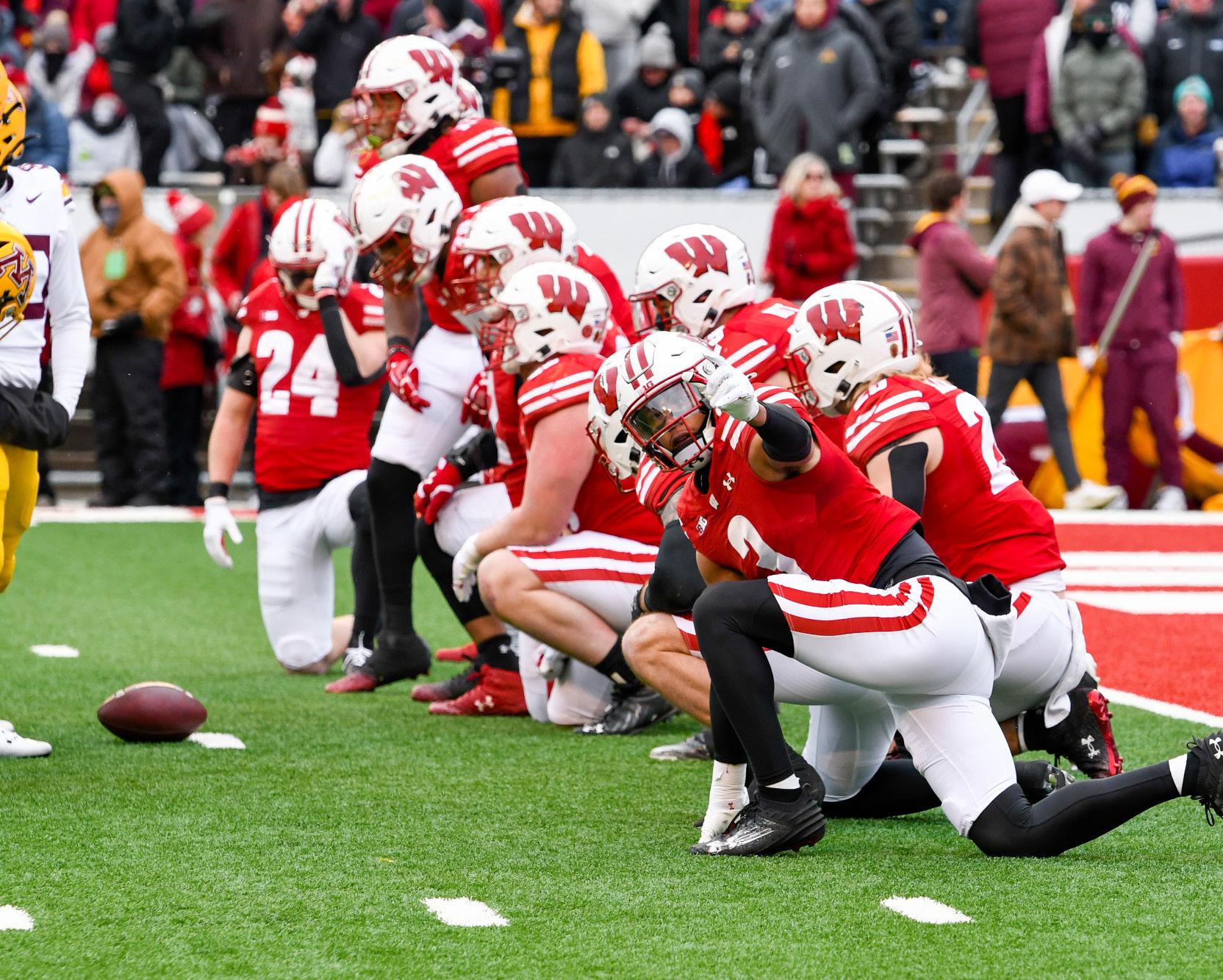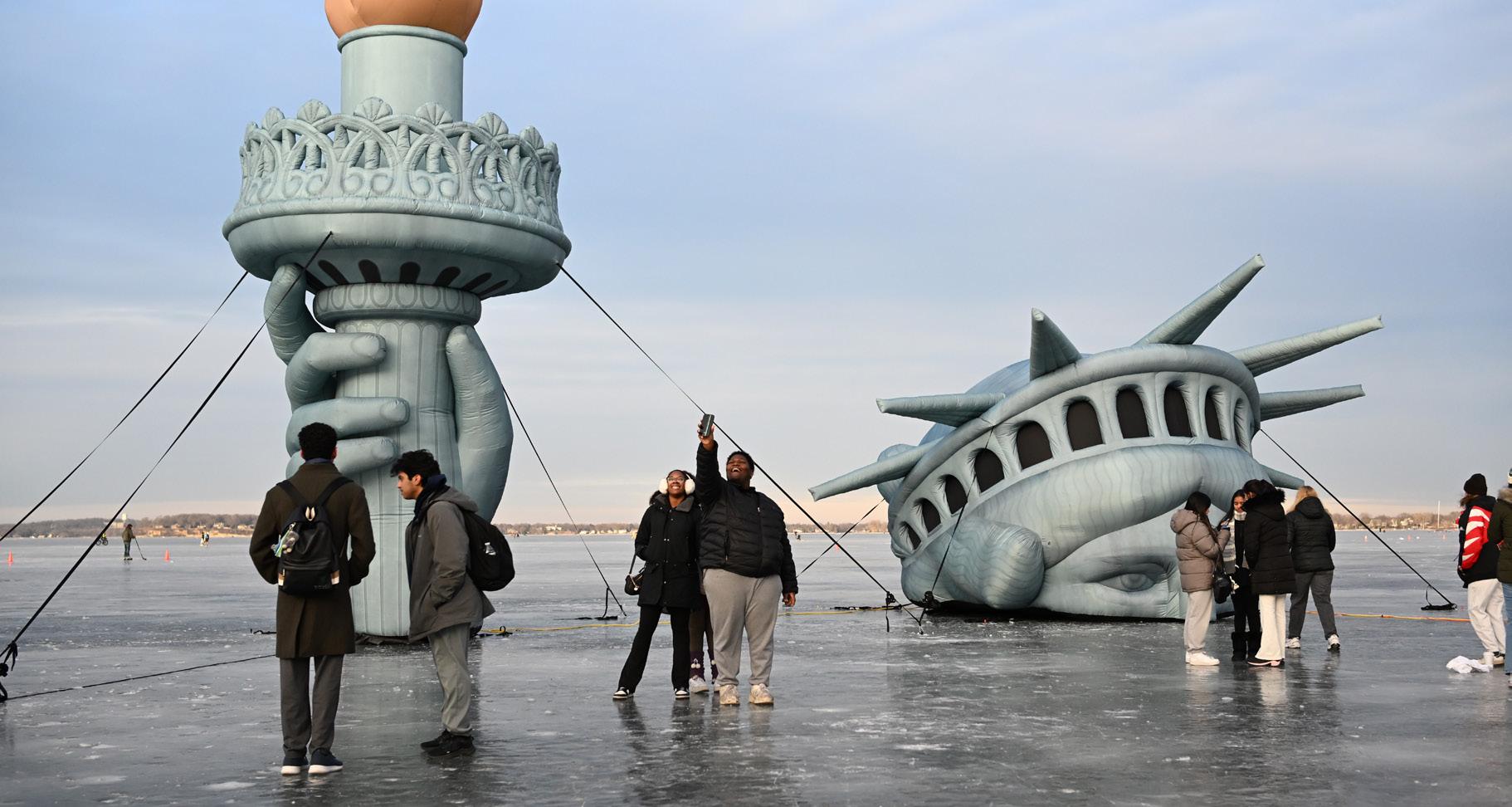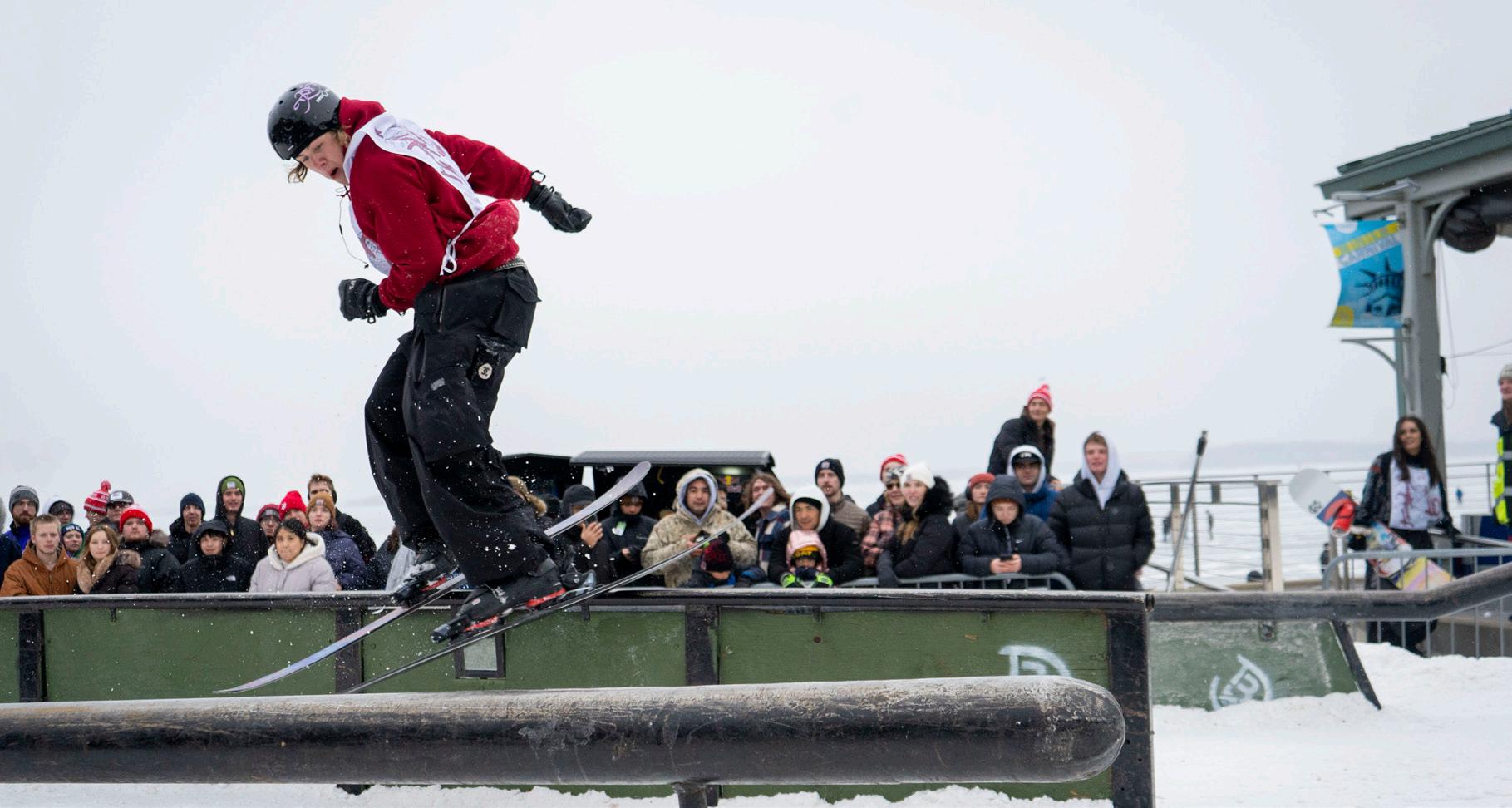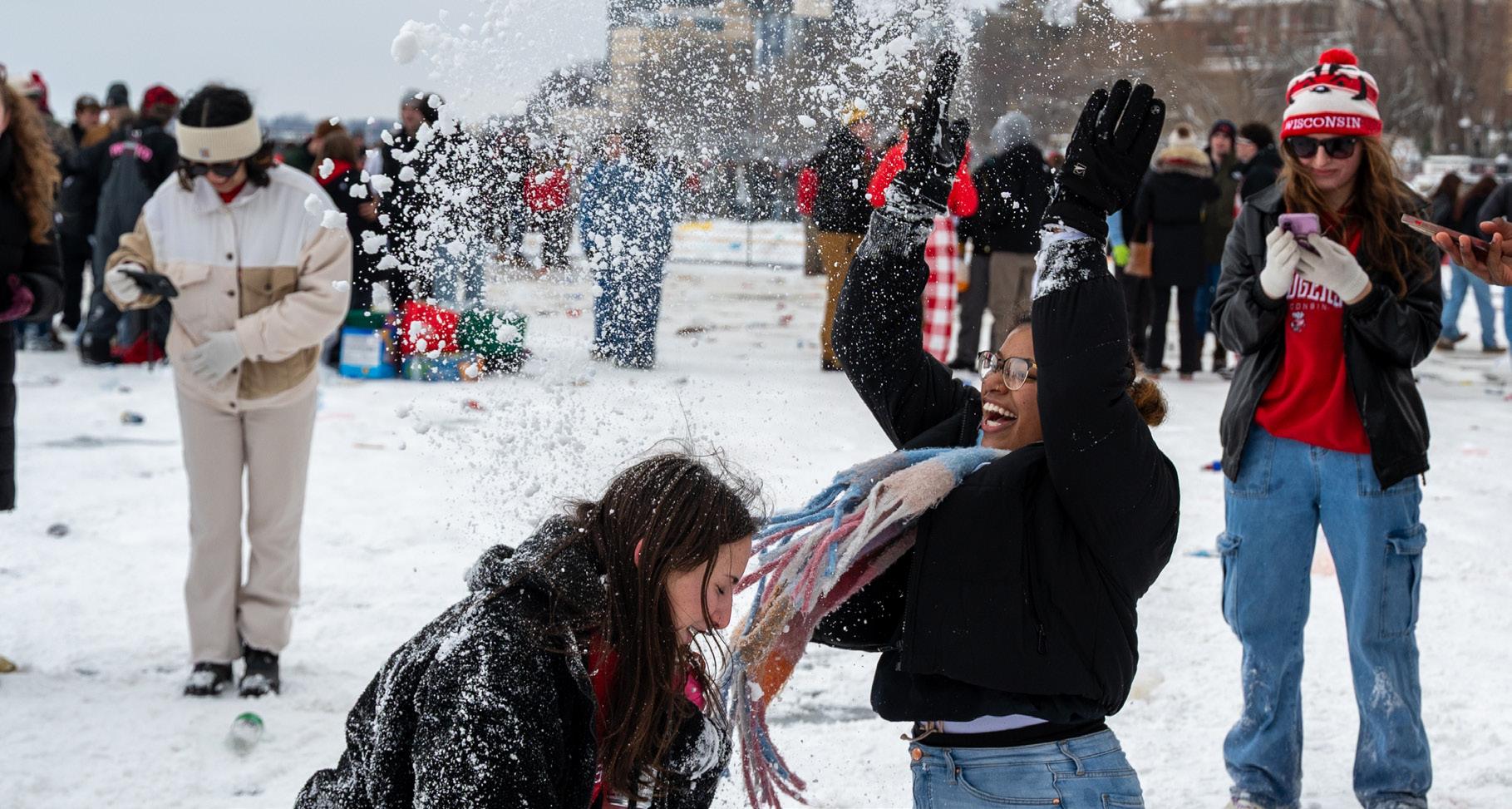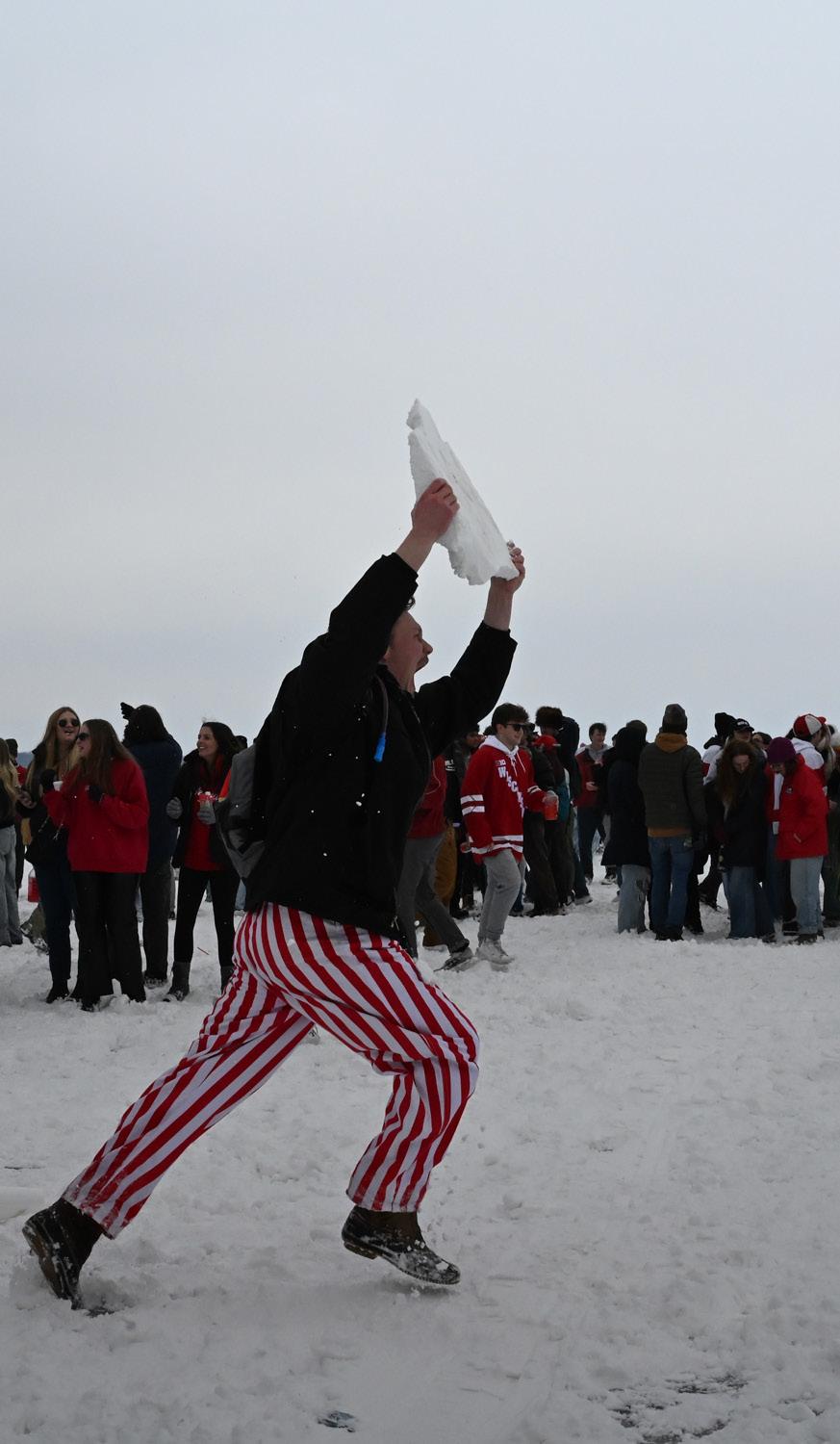






By Olivia Ruetten STAFF WRITER
Wisconsin’s incumbent State
Superintendent Jill Underly will face off against education consultant Brittany Kinser in the April 1 general election.
Voter turnout sat at just 11.98%, with 467,239 people voting out of the registered 3.9 million people in Wisconsin. This is still an improvement compared to Underly’s victory in 2021, which saw 9% of voters turning out for the election.
Underly received 38% of the vote, while Kinser came in second with 34.6% and Jeff Wright earned 27.4%.
Kinser has been backed by the conservative Moms for LibertyOzaukee County. Her support on the issue of school choice has earned
her support from Republican leaders across the state.
Despite her lack of a teaching license, Kinser advanced to the general election with a third of yesterday’s vote.
“I am inspired and humbled by the level of support my campaign has received in just a few short months. From now until April 1, I will continue to travel the state and share my plan to bring a clean slate, a fresh start and a fundamentally new approach to DPI,” Kinser said in a statement shortly after the primary was called.
Underly is endorsed by the Democratic Party of Wisconsin and the American Federation of Teachers-Wisconsin, along with other state politicians.
Democratic Party of Wisconsin
Chair Ben Wikler threw his support behind Underly, applauding her efforts to expand education access in Wisconsin.
“As Superintendent of Public Instruction, Jill helped pass a new bipartisan literacy law, raised standards for math and science, and expanded career and technical education,” Wikler said in a statement Wednesday. “Kinser’s campaign is funded by Republican megadonors and stage-managed by a former Republican legislator because they love that Kinser has promised to drain funds from our public schools and give them to private for-profit schools.”
Both Kinser’s and Underly’s campaigns support increasing student literacy rates. This is in response to criticism of Underly’s
new educational benchmark system, which Underly has repeatedly defended.
The outcome of this election will impact the way funding is distributed to schools, how schools measure student progress and parental control over children’s education.
The primary election in Wisconsin will take place on Tuesday, April 1. In Wisconsin, in-person absentee voting opens 14 days before Election Day and runs through the Sunday before Election Day.
Madison residents, including students voting with a Madison address, can vote early at Memorial Union, Union South, any Madison Public Library branch and other locations.
By Audrey Lopez-Stane STAFF WRITER
During his 2025 budget address at the State Capitol, Gov. Tony Evers honed in on the tax cuts to child care and prescription budget plans introduced at January’s State of the State, along with health care accountability and farmer support.
Tax relief to lower prescription costs
Evers plans to provide nearly $2 billion in tax relief over the next biennium. He asked for bipartisan support on a plan to lower out-ofpocket expenses for working families, including child care and prescription costs.
The budget would prevent a property tax increase for the average homeowner. As an incentive, he said local governments will receive direct payment from the state to not raise property taxes.
Evers aims to lower prescription costs and price gouging. The “Less for Rx” plan would reduce costs of life-saving medication including insulin, which would be capped at $35, and a Prescription Drug Affordability Review Board would be implemented to prevent price gouging.
Evers also wants to eliminate over-the-counter medication sales taxes, which he said would save Wisconsinites a projected $70 million over the next two years.
‘Year of the Kid’ budget plans
To further the 2025 “Year of the Kid,” Evers announced the “most pro-kid budget in state history.”
Evers’ investment would work to hire more staff, decrease waitlists and lower overall costs of child care. He said parents should not leave work because they cannot afford child care, as it is detrimental to Wisconsin’s economy.
“That’s a win-win-win-win for our kids, our families, our workforce and our state,” Evers said.
The Legislature will also be asked to approve an $80 million investment in literacy support, such as
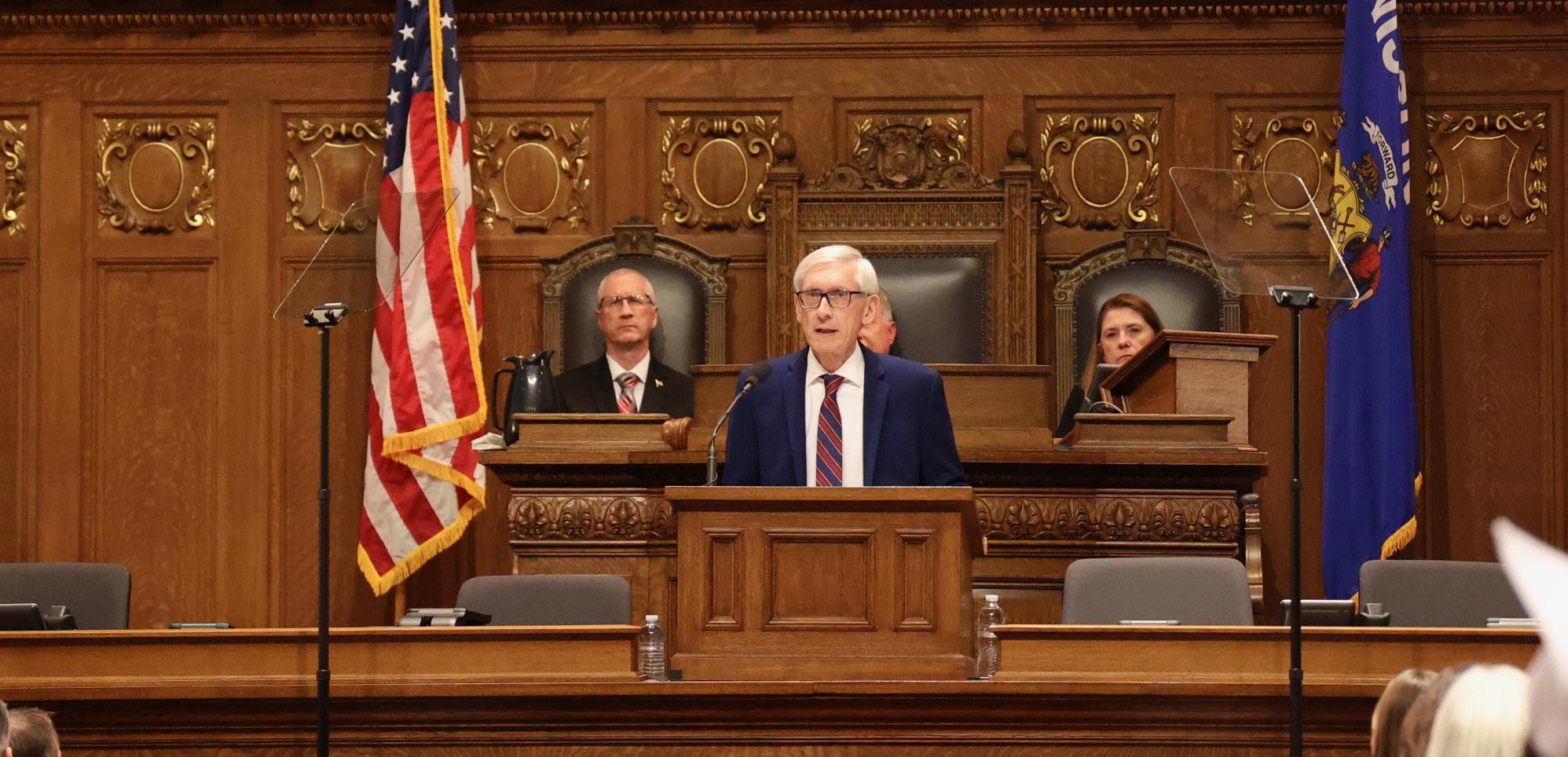
coaches and tutors, to improve the state’s reading scores. Wisconsin’s scores show only 31% of young students being proficient in reading, with Black and Hispanic students scoring even lower.
Evers also wants to combat lead exposure from water in schools and homes. He said Wisconsin kids in recent weeks have experienced lead poisoning due to “dangerous levels of lead” at school.
“At school, folks. That should never happen anywhere in Wisconsin. Period,” Evers said. He plans to invest over $300 million to remove lead from water sources with bipartisan support.
Evers will ask the Legislature to support an investment of over $145 million to eliminate PFAS contamination and provide resources to communities affected by contaminated water.
Agriculture investments
Evers addressed the effect President Donald Trump’s tariffs will have on Wisconsin exporters, farmers and consumers. He said the 25% tariff could spark trade wars that would hurt the state’s economy after working toward becoming a top 10 state for agriculture.
“We can’t afford to lose our momentum because of tariff wars in Washington,” Evers said. He wants to double investments in the Wisconsin
Initiative for Ag Exports to increase dairy, meat and crop exports, as well as expanding farmers and producers into other markets.
Earlier this month, Evers announced with the Wisconsin Department of Transportation a $100 million investment for 55 new projects across 36 counties to help farmers and producers transport their products to stores. This plan includes improvements to rural roads and infrastructure through the Agricultural Roads Improvement Program.
Tonight, Evers announced to invest another $50 million to continue the program to ensure reliable roads for farmers and producers. His plan will also create a new agriculture economist position in the state government to help farmers and producers overcome the obstacles caused by Trump’s tariffs.
Insurance company accountability
Evers aims to implement a bill to extend postpartum coverage for pregnant women on BadgerCare to up to one year after giving birth. He said this is a bipartisan bill that 48 other states have adopted and a supermajority of the Wisconsin Legislature supports.
“Wisconsinites aren’t getting a fair shake when it comes to health care,” Evers said.
Additionally, Evers wants Wisconsin to be the first state to audit insurance companies over
health care claim denials.
“If an insurance company is going to deny your health care claim, they should have a darn good reason for it,” Evers said. This plan would also create an office devoted to helping Wisconsinites get the coverage they need and holding insurance companies accountable.
Evers also wants to eliminate “prior authorizations” that require health professionals to wait for permission from the insurance company to provide care or medication.
“They’re banking on being able to avoid covering the services and treatment you need,” Evers said. Health conditions can worsen and become life-threatening between the time of request and authorization, Evers said, and he wants automatic approval.
UW System budget increase
Evers will ask the Legislature to approve an additional $856 million in funding for the University of Wisconsin System, the largest twoyear increase in history.
With the Trump administration’s federal efforts to cut higher education budgets, Evers said “UW could get a whole lot worse.”
UW System has faced multiple campus closings, tuition increases and staff layoffs, and Evers said he aims to protect the system with his budget proposal.
By Sonia Bendre STAFF WRITER
The University of Wisconsin System has temporarily paused the release of an updated copyright policy that would broaden the amount of intellectual property the university can claim from academic staff after faculty criticism.
Instead of releasing the policy, which was set to release upon approval from UW System President Jay Rothman, a working group will review public comments and proposed changes, aiming to provide feedback to the UW System Board of Regents by March.
“President Rothman is directing the establishment of a work group made up of content experts and representatives designated by shared governance leadership to review the comments and provide recommended changes to the policy,” UW Director of Media Relations Mark Pitsch told The Daily Cardinal in an email statement on Feb. 6.
When asked about the work group’s makeup and timeline, Pitsch said UW System was in the process of identifying the group.
Faculty criticize implications of policy on research ownership, AI
The policy, an updated version of an existing UW System copyright policy, first became available on UW System websites in September and removed the word “instructional” from the original title, “Copyright Instructional Materials Ownership, Use and Control,” granting UW System copyright ownership across a larger swath of material.
Other changes include determining copyright ownership based on “category of work” rather than “type of material,” removing “developmental conditions for copyright instructional materials” and adding qualifications around copyright ownership for a newly defined category of work labeled “Institutional Work.”
The complete text of the policy, which was taken down from the website, was shared with the Cardinal by the American Federation of TeachersWisconsin (AFT-Wisconsin).
AFT-Wisconsin raised multiple concerns in an open letter to UW System leadership and students in November, asserting the ownership claim “is in violation of existing policy, existing practice, and long standing traditions and principles of higher education.”
A UW-Madison faculty lobbying group, PROFS, also echoed these concerns in a Dec. 9 letter.
“The existing policy has some of the strongest copyright protections for intellectual property for faculty and staff in the country,” said Jon Shelton, AFT-Wisconsin member, professor of Democracy and Justice Studies and president of UW-Green Bay academic labor union UWGBUnited. “We were worried in particular about the fact that this seemed to state in writing that the UW System owned the copyright on all of the work that people had produced,
including scholarly work, teaching materials, syllabi, et cetera.”
In the letter, signed by presidents and councilmembers of faculty and staff labor unions across UW System, AFT-Wisconsin urged UW System to clarify that copyright ownership of Scholarly Work should be vested with the work’s author and threatened to withhold their intellectual material from Canvas if their requests were not met.
UW System legal counsel replied to AFT-Wisconsin in an email confirming it would make revisions to the updated policy, which included updating the definition of “Scholarly Work” to include syllabi and clarifying the point that copyright ownership of “Scholarly Work” is transferred to the authors of that work — although the university is still granted access to the work to use for cases laid out later in the “Conditions of Transfer” section of the policy.
AFT-Wisconsin still had some concerns, including that their instructional materials could still be used to train artificial intelligence models, but UW System legal counsel did not respond to any further emails or requests for conversation made by AFT-Wisconsin leaders, according to Shelton.
“If [UW System] defines the legitimate business purposes of the university as training AI to teach students so they no longer need professors, I don’t see anything in this policy that would prohibit that,” Shelton said.
Working group composition, specific policy updates raise concerns
With the introduction of the working group, it is unclear whether the revisions mentioned in the email are guaranteed to remain, according to Shelton. Although AFT-Wisconsin is composed of university faculty and staff, none of its members have yet been selected to be in the working group, though one board member of the UW-Madison faculty lobbying group PROFS is on the committee: Nancy Kendall, professor of Educational Policy Studies, who did not respond to an immediate request for comment.
“After I got this letter from [UW System legal counsel], they then basically retracted the policy and started over, I guess, with this working group,” Shelton said. “So I have no idea what’s actually going to come out of this. Are those new safeguards even going to be in there? This has all been a black box, and again, they’re not talking to the people who had the concerns in the first place.”
Both the American Federation of Teachers (AFT) and the American Association of University Professors (AAUP) confirmed the original draft of the updated policy would infringe upon the AAUP’s statements on Copyright and Intellectual Property, according to the letter. These concerns were sufficiently recognized by the revisions that UW System legal counsel sent to AFTWisconsin, according to Shelton,
although the legal counsel disputed that even the original updated policy infringed upon those guidelines.
Dorothea Salo, a scholarly communication librarian and member of the United Faculty and Academic Staff labor union at UW-Madison, spoke about her discomfort with the updated policy at a UFAS-sponsored event on Feb. 4 titled, “Who Owns Your Academic Work?” Salo could not locate the text of the policy, and expressed worry at the difficulty of finding information on the policy specifics — aside from the changelog and a list of frequently asked questions, no other details are available on the UW System website.
“Even if this was a mistake, even if this was well-intentioned in some ways… I really expect the Regents to do better,” Salo said, adding the issue of demarcation between research products and instructional products has existed for a long time. “Faculty have thought of themselves as independent operators within a university… while the employer does incentivize research production, it does not specify that content in the way that a typical work-for-hire environment would.”
A work-for-hire environment is a term built into United States copyright law. Essentially, if an employee is hired to produce material that could be considered copyrightable, the employer becomes the copyright holder. Anything fixed in a tangible medium of expression can be copyrightable, including software, digital files, essays, papers, books, music and recordings.
But universities operate somewhat differently. Because faculty largely dictate research work rather than the university administration, these faculty members have been allowed to hold their own copyrights, according to Salo. The new policy would affect not only faculty but also instructional academic staff, potentially limiting the scope of their ability to control what their academic materials are used for.
“We’re sitting here, by the way, because this is a union-sponsored event,” Salo said during the event. “If the fruits of our labor are basically being taken away from us, we have concerns.”
Both letters, and Salo, expressed concern that their course materials could be taken without consent and used in online courses that the original authors of the course material would not be involved in. Other concerns included the possibility that low-skilled workers or AI could be made to proctor the original author’s course, reducing its value to students.
“Whether it’s Jay Rothman strongly suggesting that campuses with large numbers of low-income students cut majors that supposedly don’t give people jobs, or UW System’s new policy that senior level searches for UW System employees no longer have to have a search committee… There’s a consolidation of power and a deficit of trust with the UW System,” Shelton said.
Reporting contributed by Staff WriterTedHyngstrom
By Gavin Escott CAMPUS NEWS EDITOR
The future of the University of Wisconsin-Madison’s diversity-based scholarships are in doubt after a U.S. Department of Education decision Friday ordered schools to eliminate race-based programs.
In a Feb. 14 letter addressed to schools, the department warned schools they risk losing federal funding if they continue taking race into account when making “financial aid, hiring, training, and another institutional programming” decisions. The department gives schools two weeks to comply with the decision.
UW-Madison currently awards diversity-based scholarships and has a host of “cultural centers, campus resources, student organizations, focus groups, listening sessions, and equity and inclusion activities [that] may have race-related themes as long as they welcome all students,” according to the university.
Scholarships, such as the Mercile J. Lee Scholars Program and The Falk Diversity Scholarship, are explicitly geared towards attracting and supporting students from “underrepresented groups.”
When asked if these scholarships and other race-based programs would be eliminated, UW-Madison spokesperson John Lucas told The Daily Cardinal university leaders are reviewing the Department of Education’s memo and would share more information when they have guidance or additional clarity. Lucas reaffirmed the university’s commitment to diversity.
“UW-Madison is committed to a campus environment that values diversity in both background and viewpoint, and fosters inclusion and belonging for all students, faculty and staff,” Lucas said.
The Department of Education’s decision “clarif[ies] the Department’s interpretation” of the U.S. Supreme Court’s June 2023 decision overturning affirmative action. The court ruled the use of race in admissions is unconstitutional but clarified racially classifying and assigning students is lawful only if it achieves a compelling interest, which the court defines as remediating instances of past unconstitutional discrimination or avoiding imminent risks to safety.
In the letter, the department asserted the Supreme Court’s decision “applies more broadly.”
“At its core, the test is simple: If an educational institution treats a person of one race differently than it treats another person because of that person’s race, the educational institution violates the law,” the letter said. “Federal law thus prohibits covered entities from using race in decisions pertaining to admissions, hiring, promotion, compensation, financial aid, scholarships, prizes, administrative support, discipline, housing, graduation ceremonies, and all other aspects of student, academic, and campus life.”
After affirmative action was overturned, UW-Madison told the Cardinal diversity, equity and inclusion remains a “high priority” for the university and would continue awarding scholarships.

By Eiman Mir STAFF WRITER
Nellofer Khilji runs one of a growing number of catering services helping South Asian students at the University of Wisconsin-Madison find a taste of home in Madison, growing their businesses by connecting with students in a way that provides more than just convenience.
Khilji first started cooking commercially when she opened Shalimar Catering in 1999 after moving to Madison with her husband. Her restaurant was located on University Avenue. After two years, they decided to shift their catering business to home-based after deciding to spend more time with her kids while balancing food service.
“It was hard. When you are new in the business, there is a lot of money needed for investment and advertising,” Khilji told The Daily Cardinal. “I also had to take care of my kids. It took a lot of time and effort to start this, but it was worth it.”
Khilji typically starts her day at 7 a.m. and often cooks until 4 p.m. She delivers the food after she’s done cooking for the day. Each week she makes food for around 10-15 clients. Most weeks, she goes to the grocery store every day, frequenting Woodmans, Costco and local
Indian grocery stores.
On the University of Wisconsin-Madison campus, Khilji delivers food to students from a variety of diverse backgrounds, ranging from local to international students.
“I get a lot of calls from parents in India, Dubai, Saudi Arabia and Pakistan asking for food deliveries. I was surprised by the number of calls [at first],” Khilji said, noting that she found out her name was appearing in group chats of parents with international students after inquiring how the parents reaching out knew her number.
Khilji has never spent any money on advertising her business, saying that word of mouth, especially on campus, has helped her business grow tremendously.
“I work really hard. But that’s why I think my business is successful, because I always give time to the customer, whatever they want, whenever they want, even early morning, late night,” she said.
In addition to regular customers, Khilji also caters weddings, parties, graduations and iftar events during Ramadan, providing catering to events with over 300 guests. Khilji said Ramadan is one of the busiest times during the year for her, noting she cooks while fasting through all 30 days of Ramadan, a sacred month observed by
Muslims worldwide.
Udita Suresh, a sophomore at UW-Madison, found Khilji through a group chat of Indian students. Having a service like Khilji’s isn’t just about convenience, Suresh said. It also means being able to enjoy the luxury of food that reminds her of home.
“Good food is what gives me the fuel to function and keep up with whatever the day demands. Obviously, nothing can beat the kind of food you get at home, but people like her try their best to offer that,” Suresh said.
MOONHALF Halal Eats, a food catering business which combines Indian and Pakistani food with American fusion, is another catering service helping South Asian students in Madison find a taste of home.
Tayba, who is 28 years old and asked to be referred to by her first name only, opened Moonhalf Halal Eats more recently after moving near the Madison area. Before moving to Madison, Tayba was attending school in Michigan and realized her love for cooking.
As a former international student, Tayba knows how it feels to miss home-cooked meals and is motivated by the opportunity to connect with college students through good food.
“I love meeting kids and ask-
By Anna Kleiber STATE NEWS EDITOR
Gov. Tony Evers proposed an over $856 million investment in higher education, the largest two-year increase in state funding for the University of Wisconsin System in state history, during his 2025 budget address Tuesday.
Evers declared 2025 “The Year of the Kid” during his seventh State of the State address in January, calling for a significant investment in education for Wisconsin’s kids from preschool to college. Ahead of Evers’ budget address, he described his biennial budget proposal as the “most pro-kid budget in state history.”
“Politicians in Washington don’t know a darn thing about what’s going on at campuses across Wisconsin. They don’t understand that our UW System has been part of Wisconsin since we first became a state — it’s enshrined in our state constitution,” Evers
said. “They don’t know how important our UW System has been to our state’s success or how important it is for our future.”
With the Trump administration’s federal efforts to cut higher education budgets, Evers said “UW could get a whole lot worse.”
UW System has faced multiple campus closings, tuition increases and staff layoffs, and Evers said he aims to protect the system with his budget proposal.
“[Wisconsin’s] ability to compete and be successful — to have a strong economy and workforce, to retain our homegrown talent, to solve problems in our smallest towns, to our largest cities and to make life better for everyone who calls our state home — depends on our UW System,” Evers said. “It’s up to us — each of us, together—to invest in our UW System, to defend it, and to protect its promise for future generations.”
Republican lawmakers, who control the state Legislature and the budget-writing pro-
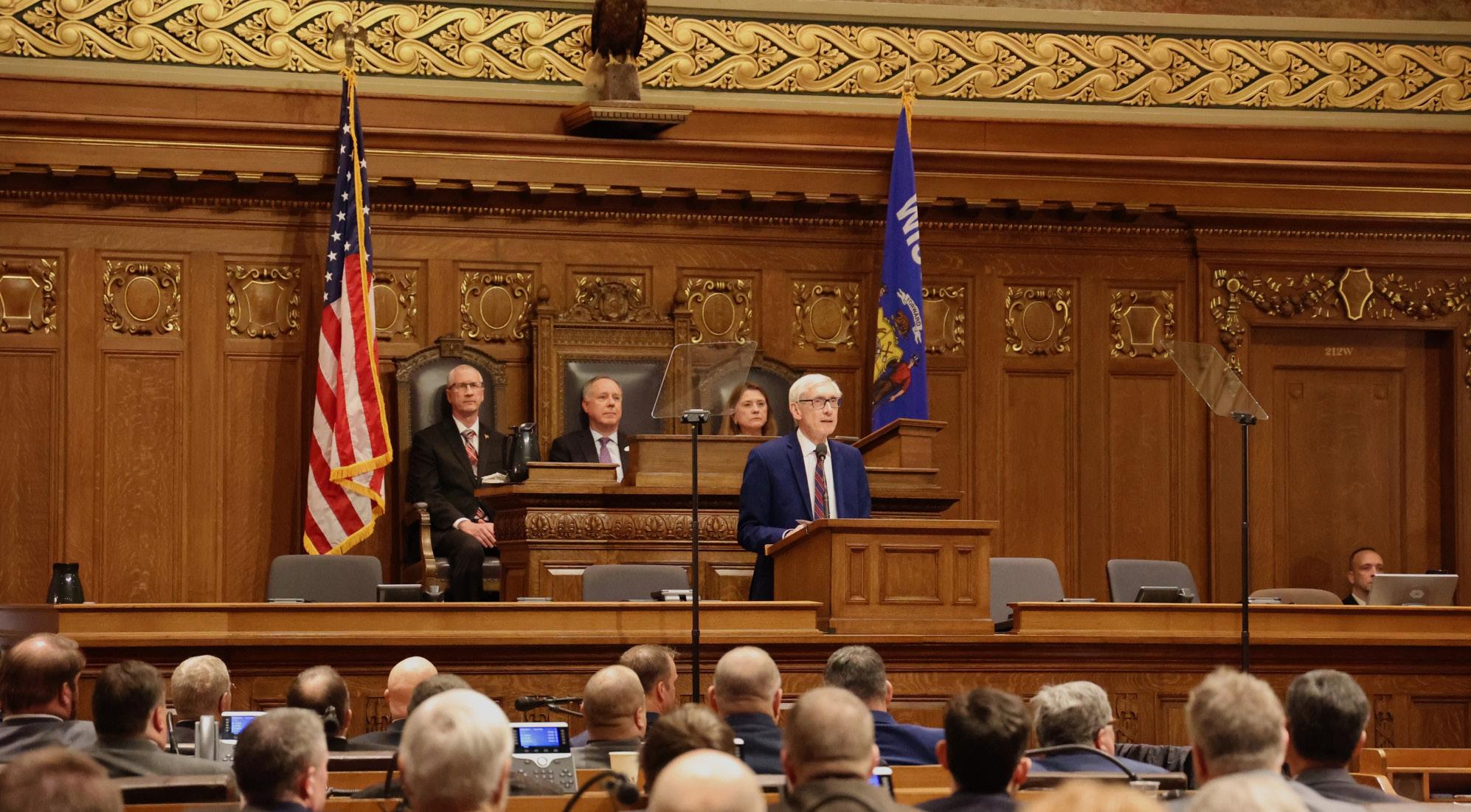

ing how life’s going, how their school is,” she said. “I think a lot of international parents, especially, are very concerned for their kids since they’re so far away. So the service you offer is very reassuring to them. It feels so good when parents in India, Pakistan, Bangladesh or Saudi [Arabia] reach out to thank you.”
For Tayba, it’s important that students are able to access good food without worrying about the costs. At Moonhalf Halal Eats, Tayba tries to keep a “very minimal price” and charges about $8 for one meal, saying she believes it’s important that students can access good food without worrying
about cost. The servings are large, so you can eat multiple meals from one box.
Like Khilji, Tayba, hears from parents who appreciate her food for international students, like one mother who felt grateful that her son could have a taste of home despite being so far away.
“She was a little sad and crying. She was saying that her son is a freshman and he just came from India and he’s not feeling well. But she wants him to eat,” Tayba said. “She was saying, ‘If I were there, I would cook daal chawal.’ So she was asking if I could do that. I said, ‘Yeah, you can share your recipe.’”
cess, have pledged to throw out the governor’s proposed spending plan and write their own.
“We are not going to let Wisconsin become Tim Walz’s Minnesota,” Assembly Speaker Robin Vos, R-Rochester, said after the governor’s address, adding that Evers’ spending proposals are “dead on arrival.”
And with the National Institute of Health’s looming decision to cap indirect cost rates to 15% for all new and current grants, major research institutions like the University of Wisconsin-Madison, whose rate ranges from 26% to 55.5%, could suffer if the state doesn’t increase funding to address the shortfall.
Without additional funding from the state, the UW-Madison would need to increase tuition to cover the potential annual $65 million loss if a federal decision cutting research funding is implemented.
Vos told The Daily Cardinal on Feb. 12 that “it would be impossible for the state [of Wisconsin] to replace federal funding,” citing the need to maintain a balanced budget.
Higher education officials applaud Evers’ budget proposal
Nearly 90% of in-state UW System graduates stay in Wisconsin five years after earning a degree from one of Wisconsin’s 13 public universities. By investing in higher education, UW System President Jay Rothman said in a statement Tuesday that Evers’ proposal demonstrates a “desire to win the war for talent.”
University of Wisconsin-Madison Chancellor Jennifer Mnookin said in a statement Tuesday that with Wisconsin currently ranked 43rd out of 50 states in state support for four-year higher education, the governor’s call for a significant increase in state
funding will bolster Wisconsin’s economy and expand opportunities for Wisconsinites.
“The governor’s proposal would put that unflattering and uncompetitive ranking behind us while bringing Wisconsin to the national median. With it, the UWs have targeted investments on affordability, access, innovation and talent development that will ensure Wisconsin is ready for a brighter future,” Rothman added.
Additionally, Mnookin said an increase in state funding is especially important as the nation faces “tremendous uncertainty” and risks to federal funding under President Donald Trump’s administration. Federal funding accounts for roughly a quarter of UW-Madison’s total budget.
In addition to increased UW System funding, Evers’ proposal included nearly $60 million to support the Wisconsin Technical College System (WTCS) to invest in green jobs, the state’s health care workforce and worker training for artificial intelligence.
The additional funding would allow WTCS to meet the demand of employers for different industries, bring more people into the system and better support students, policy advisor Megan Strichko said at a news briefing Jan. 30.
Wisconsin’s technical colleges, made up of 16 schools with over 50 campuses, cover every corner of the state and serve 287,000 Wisconsinites every year. Their goal is to serve community needs by offering education and skills training to keep up with the current demands of the workplace.
While the technical college system, along with UW System and public K-12 schools, requested an increase in funding from the state, it is unclear if an increase in funding for all three will make the final cut.
By Daniel Frisch STAFF WRITER
Madison Mayor Satya Rhodes-Conway, along with a group of other alders, introduced several proposed amendments to the city’s zoning code to the Madison Common Council on Jan. 14, and will be voted on Feb. 25.
The city of Madison said in a press release the proposed amendments to the zoning code cover an array of different policies designed “to better facilitate small residential developments that are already generally allowed.”
“The biggest problem in the city is housing and the lack of affordable housing, ” District 8 Ald. MGR Govindarajan told The Daily Cardinal.
With the population of Madison expected to grow to
385,000 people by 2050, the zoning change aims to be “forward looking” and “planning for the future,” Govindarajan said.
“It’s making sure people don’t get priced out of their current homes, but also that there are more homes in the future,” he said.
The city has made the student housing market a priority over the past two years, Govindarajan said, referring to measures such as the city’s change to the zoning code targeted at creating more affordable student housing last fall. The new changes are mainly targeted towards the regular rental market and the home ownership market, and Govindarajan said that students will also see benefits.
“Students used to compete with other students to
get housing,” Govindarajan said, but since the COVID-19 pandemic, students have been increasingly competing with recent college graduates with greater incomes. By helping create and expand housing around the downtown area, the market can be freed up for students, he said.
The changes “would let community members take into their own hand the ability to create more housing,” Govindarajan said, while further conversations about what direction the city should go in are had.
“Housing is a big problem that the entire city is facing and we have to solve it in multiple different ways,” he said.

The Common Council is expected to vote on the proposed amendment at their meeting next Tuesday. Govindarajan is optimistic that the changes will pass,
having heard no major opposition, but he is “sure there is going to be a big fight.”
By Avery Chheda STAFF WRITER
Frances Huntley-Cooper has dedicated her life to public service. She was a social worker for 28 years, an alderwoman and in 1991 — against all odds with little political ambition — became the first elected Black mayor in Wisconsin.
But as a shy girl from Lisbon, a small, segregated town in North Carolina, she never expected to end up in politics.
“I was real quiet growing up,” HuntleyCooper said. “I was considered a very reserved student.”
Huntley-Cooper attended an all-Black elementary and middle school. Her mother then insisted she attend the predominantly white high school across the street from their home. Huntley-Cooper and three other girls made up the school’s entire Black population.
“In the end, it was a good experience,” Huntley-Cooper said.
Huntley-Cooper’s shy nature was offset by her mother, a small yet outspoken woman who ran a local day care. Her mother was a strong advocate against injustice and became “a voice for the voiceless,” Huntley-Cooper said.
When she wasn’t in North Carolina, Huntley-Cooper was visiting family in New York. Life in a small Southern town was nothing compared to a vibrant place like New York, where as a teen, Huntley-Cooper exposed herself to culture, fashion and artistry she’d never seen before. She spent hours in Macy’s, wearing clothes she couldn’t in public, to be somebody she couldn’t be in a small town.
New York’s ethnic and cultural diversity also proved helpful, teaching HuntleyCooper how to engage with people in an unfamiliar manner.
“That’s how I’m not afraid to ask questions,” Huntley-Cooper said. The city provided Huntley-Cooper with a myriad of new experiences. For once, she was able to engage with people in a way she couldn’t back home, a crucial development to becoming a social worker.
“I think that helped me open up,” Huntley-Cooper said. “I grew up in a place where you’re not supposed to ask people questions, so for me to go into social work, the first thing you’ve got to do is ask people questions.”
In 1970, Huntley-Cooper enrolled at North Carolina A&T, the same HBCU as her moth-
er, and later her sister, daughter and nieces. There she developed strong relationships and learned valuable lessons in the school’s chapter of Alpha Kappa Alpha, a Divine Nine historically Black sorority.
“There are things I’ve learned in this organization as a sorority sister that I would have never learned anywhere else,” HuntleyCooper said.
Since her initiation, Huntley-Cooper has stayed active on every level. She would eventually carry many of those leadership lessons with her throughout her professional career.
Huntley-Cooper enrolled at the University of Wisconsin-Madison in August 1973 to earn a master’s degree in social work. It was here, far from her mother’s passion, that she found her own voice.
”Growing up, I observed that [passion]… when I moved away and I didn’t see all that happening, that’s when my voice came out,” Huntley-Cooper said.
Huntley-Cooper was keen on helping disadvantaged youth and said helping others came naturally to her. When she realized Black students at UW-Madison were not receiving the same support and encouragement she witnessed at North Carolina A&T, she wanted to change that.
She ran for Fitchburg City Council as a write-in candidate in District 1.
“I probably got 52 votes,” HuntleyCooper said, but it was enough to carry her to victory.
She served as an alderwoman for two years. In her second year, she was joined by another woman, Jo Bernhardt. After a difficult term, Bernhardt told Huntley-Cooper she would not run for reelection. HuntleyCooper remembers her saying, “I can’t take it. I don’t know how you do it.”
Huntley-Cooper found her background in social work gave her the strength to be an alderwoman.
“If you have to take a child away from the parent and put them in foster care…that’s the hardest job [you’ll] have to do,” HuntleyCooper said.
Tom Capp, then mayor of Fitchburg and mentor to Huntley-Cooper, pushed her to run for mayor. Initially, HuntleyCooper was resistant and thought politicians were more polished than her. But Capp insisted she was right for the job — and unbeknownst to her — mentioned

Huntley-Cooper as his preferred replacement over the radio. Ultimately, it was enough to convince her to run.
Capp went on to help run her campaign alongside her colleague Mike Fahey. Fitchburg’s first female mayor, Jeanie Sieling, also guided her.
Huntley-Cooper proved Capp knew what to look for in the next mayor, presenting as a serious, focused and composed mayor. She said she wasn’t intimidated by her work — or balancing being a mother, wife and working full-time — thanks to her experience as a social worker.
When she began her campaign for mayor, she made it clear she wouldn’t let her race stand in the way.
“I said, ‘race is not an issue,’” HuntleyCooper said. People didn’t expect Fitchburg to be the home of the first Black female mayor, but Huntley-Cooper had no issue being a trailblazer. Because she had a habit of saying things straight, she found she didn’t meet substantial pushback. While she could have used more support, she said she at least wanted to “leave the doors open for people after me.”
She was elected in 1991. Roughly 30 years later, Huntley-Cooper was finally followed by the second elected Black mayor in Wisconsin, Milwaukee’s Cavalier Johnson.
“I’m delighted Cavalier Johnson was elected, but it shouldn’t have taken that long,” Huntley-Cooper said.
When she first came to Wisconsin for school, Huntley-Cooper never expected to build a life here.
She took a job in a group home for Dane County, with the intent of getting experience before moving on. But before long, she met her husband and ended up getting married and having kids.
Fifty years later, Huntley-Cooper still calls Fitchburg home.
“I don’t think there’s anywhere else I’d rather be,” Huntley-Cooper said.
While she loosely considers herself retired, Huntley-Cooper tries to stay active in the greater Madison area. This includes being a member of the Madison Community Foundation, a delegate for multiple Democratic National Conventions, president of Capital City Hues, a newspaper serving people of color in Madison, a sorority sister and former president of TEMPO Madison. Huntley-Cooper has also been involved in creating Madison’s Center for Black Excellence and Culture. The center, the brainchild of Rev. Dr. Alex Gee, will open in 2026 and support thousands of Black community members. Different programs in the building will be dedicated to wellness, seniors, students and artists. Huntley-Cooper has been raising funds to make the center completely free for community members since joining the project.
“It’s been amazing to watch that develop,” Huntley-Cooper said. “It’s a joy to serve this community.”
The charity hockey tournament raised nearly $18,000 for epilepsy research on Saturday.

By Julia Walkowicz
STAFF WRITER
Sigma Alpha Epsilon (SAE) held its annual Lily’s Classic hockey tournament and fundraiser as normal on Saturday.
Lily’s Classic celebrated its 11th year as hundreds of attendees slip-slided their way onto Lake Mendota, raising money through a four-versusfour “boot hockey” tournament to benefit Lily’s Fund, which supports epilepsy research at the University of Wisconsin-Madison.
After last year’s cancellation due to poor ice conditions, SAE’s event was a knockout, drawing 850 attendees inside the house, according to Philanthropy Chair Alex Orman. The crowds that sprawled over the surrounding Lake Mendota were more than three times this amount. Through GoFundMe, merchandise sales and a collaboration with local bar The Kollege Klub, the event raised nearly $18,000, Orman told The Daily Cardinal.
SAE developed a relation-
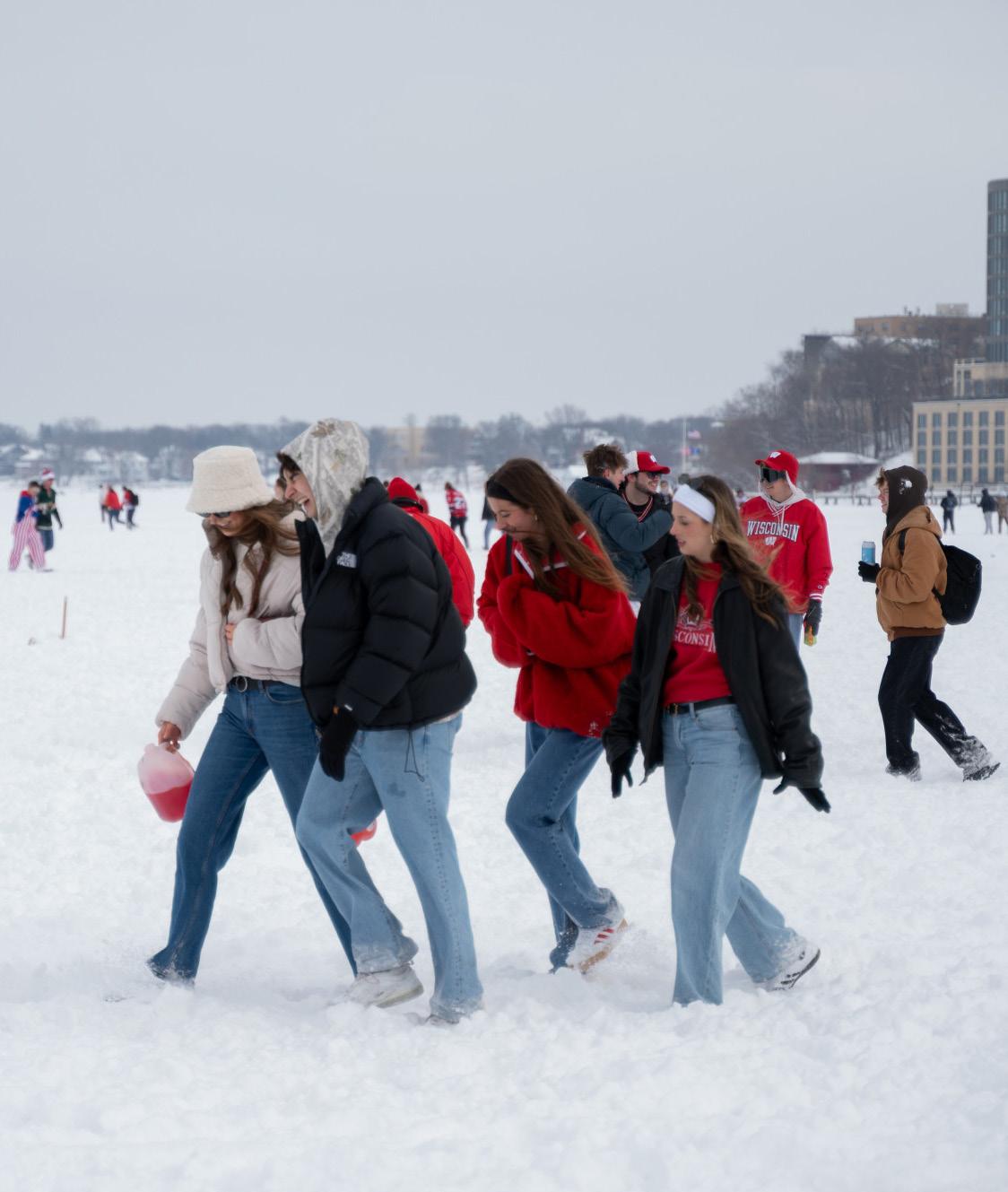
Lauren Aguila PHOTO EDITOR EMERITUS
“Is everything okay?” Chuckie Brown-Soukaseume asked his wife, Jamie Brown-Soukaseume, over the phone back in 2023 after receiving her five missed calls. “I just got nominated for a James Beard,” Jamie BrownSoukaseume replied.
Jamie Brown-Soukaseume is the executive chef and backbone of Ahan, a restaurant serving Asianinspired dishes at 744 Williamson St. in Madison. She won Madison Magazine’s 2024 Chef of the Year alongside nominations for two James Beard Awards, Best Emerging Chef in 2023 and a semifinalist spot for the 2025 Best Chef: Midwest category.
Chuckie and Jamie BrownSoukaseume are the founders and co-owners of Ahan. The COVID-19 pandemic led to their first restaurant opening in August 2020. They shared their pop-up features at The Robin Room on Madison’s East Side and originally planned to open a food truck.
The business was so busy from the beginning that it would run out of multiple recipe items in just a few hours, Chuckie Brown-Soukaseume told The Daily Cardinal. Then, it moved to its larger current location in the bustling Willy Street neighborhood.
ship with Lily’s Fund after a member had a personal connection to the nonprofit’s founders Anne and Dave Giroux, who created the fund at UW-Madison Foundation in honor of their daughter, Lily.
“It has grown to a pretty large scale since,” Orman said.
Orman recognizes the positive connection that Lily’s Classic has on the UW-Madison community, exemplifying the “work hard, play hard” value of students.
“It brings together everything that Wisconsin encompasses — Greek life and nonGreek life, together,” Orman said. “It encapsulates what Wisconsin is about.”
Even while snow covered Lake Mendota, the temperature rested in the single digits and many people fell on the ice, students couldn’t help but swarm the lake decked out in Badger gear. To navigate the massive crowds, some outstretched shovels, skis and even a hobby horse as landmarks for searching friends.
“I think it really embodies the school spirit, bringing everyone together on the lake. It’s a quintessential Madison experience,” Nina Reichstadter, a freshman at UW-Madison, told the Cardinal.
While many UW-Madison students have exams this upcoming week, they were happy to gather outside and support an important cause like Lily’s Fund.
“It’s the UW mindset: Lily’s on Saturday, midterms on Monday. You have to earn it, you know?” said Henry Collins, a junior at UW-Madison.
restaurants in Beaver Dam and eventually moved to Madison and opened Ha Long Bay, a Vietnamese restaurant at 1353 Williamson St. Jamie Brown-Soukaseume has been an influential force in the community, starting her career in the city’s restaurant industry in 2011.
What makes Ahan unique is the story behind its creative menu. Both the owners’ mothers actively work to keep Ahan running — Chuckie BrownSoukaseume’s mother works part-time and Jamie BrownSoukaseume’s mother, Manola Hoang, is one of the head chefs in Ahan’s kitchen. Chuckie and Jamie Brown-Soukaseume met in Madison doing what they love: cooking. The essences of family and compassion encompass the restaurant.
Chuckie BrownSoukaseume believes Ahan is here to stay for a while.
“We love the neighborhood. There’s so much already in place here, and so much more just developing in this area of Madison…I don’t see us anywhere other than right here,” he said.
The Ahan staff is proud to be a part of Madison’s growing food scene and appreciates the support of their regulars and newcomers to the restaurant, Chuckie Brown-Soukaseume said.
Ahan is an Asian-fusion restaurant that serves traditional dishes from Laos, Thailand and Vietnam like Praram Long Song with a simple, modern twist. A typical special incorporates staple ingredients paired with a fun idea — poutine with a pho gravy or Orange-Jasmine Dole Whip are some examples.
Ahan’s food is “grounded in the traditional Lao flavors,” Chuckie Brown-Soukaseume said.
“We just really pride ourselves in putting out something that’s top notch,” said Chuckie Brown-Soukaseume.
Members of Jamie BrownSoukaseume’s family owned
“When you have a scene that is as strong as Madison’s, it’s just beneficial to everybody, the restaurants, the creatives, the people in the community that have so many people pushing each other to be better,” he said.
The interconnection and “friendly competition” of Madison’s culinary community “is helping make the city the destination spot it’s becoming,” said Chuckie Brown-Soukaseume.
Ahan is open from 4 p.m. to 10 p.m. Tuesday, noon to 3 p.m. and 4 p.m. to 10 p.m. Wednesday through Saturday and noon to 3 p.m. and 4 p.m. to 8 p.m. Sunday.

By Bryna Goeking & Rebekah Irby ARTS EDITORS
John Green embraces the label of a “life-long learner” — from European history, young adult novels and, now, tuberculosis.
Since starting his YouTube channel in 2007, Green has committed years to the pursuit of education and fostering curiosity in young minds.
“I see that as the thing my brother [Hank Green] and I were put on the Earth to do — to pursue our own curiosities and inspire curiosity in other people,” Green told The Daily Cardinal in an interview.
This belief was not something Green was born with, but rather he fostered with age.
“When I [was younger], I thought of school as a series of hurdles I had to jump over in order to receive a piece of paper that said I could be an adult. I didn’t know why the hurdles were there, and I didn’t feel like I was empowered to ask why the hurdles were there,” he said. “But then eventually I discovered that learning is the most interesting thing we get to do as humans.”
In addition to being a “New York Times” best-selling author, Green has co-hosted “vlogbrothers” and “Crash Course” with his brother on YouTube for 18 and 14 years respectively, becoming a familiar face in classrooms across the country. In recent years, he’s turned his passion to global health equity, becoming synonymous with the fight against tuberculosis, which he calls “the ultimate disease of injustice” and is the subject of his upcoming book “Everything is Tuberculosis.”
Before discussing his recent endeavors, it’s important to properly contextualize Green’s long-standing impact on education. “Crash Course” started as a passion project by the Green brothers, becoming more “rigorous” since its debut in 2011,

working with experts to cover subjects from science to social studies. But its goal has stayed the same: to provide free, enjoyable education for anyone curious enough to click play.
“We were trying to make the argument that learning is or should be pleasurable and that you should enjoy being able to understand the world around you more deeply,” Green said. “But sometimes the joy of that is kind of sucked out of the experience by textbooks, multiple choice tests, SATs — it’s a little soul crushing. And so, how do we bring back some joy in learning, is the question we’re always asking ourselves.”
Beyond the joy of learning, Green is concerned about the joy of future generations, specifically in relation to the cur-
rent political and health climate, something Green “didn’t experience when [he] was a kid.”
“I feel really bad for [your generation] because you lived through COVID, which has been — I don’t want to use past tense — just a tremendous shock to the social order. And now you’ve lived a lot of your lives with a level of political instability in the United States,” he said.
“I really feel like we failed you,” Green said. “And I’m sorry.”
But if Green can do one thing, it’s remain steadfast amid the existential dread that would exhaust a normal person. His work speaks for itself, and his character speaks even louder.
When members of the Cardinal thanked him for his vital role in helping them pass

their history exams, Green simply said, “I think you did that [yourself], but I’m happy to take a little credit.”
That sentiment embodies the character of Green — an online personality who not only cares about his subscriber count, but the wellbeing and education of his followers (and even his haters). Green’s educational pursuits don’t just concern students passing their exams either, but exploring all aspects of the human experience.
In his upcoming book “Everything is Tuberculosis,” Green explores the ongoing impact of a disease that kills 1.25 million people per year despite being entirely curable. Green said a lack of funding, as well as the Donald Trump administration’s freeze on funding for foreign aid, inhibit efforts to mitigate the impact of the disease.
“People are dying of tuberculosis today who don’t need to die, and that is a direct result of the choices made by the new administration. It’s heartbreaking,” he said.
Halting current treatment efforts puts the world at greater risk in the future, Green added.
“When you interrupt someone’s treatment to cure tuberculosis, that dramatically increases the chance that they’re going to have drug resistance, and that becomes harder to cure,” he said. “It also means that drug resistant [tuberculosis] is spreading throughout a community, which is extremely dangerous, not just to that community, but to the whole world.”
Green said his continued fight for access to life-saving treatments across the globe is motivated by a strong commitment to fight global health inequality.
He became focused on tuberculosis specifically after meeting a 17-year-old boy named Henry struggling with the disease, who Green said reminded him of his own son, Henry.
In the face of looming threats to health care access, Green reminds himself that progress is still possible.
“In the time that I’ve been an adult, I’ve seen a 50% reduction in child mortality globally. That’s incredible. That’s one of the greatest achievements in human history,” said Green. “It happened slowly, but it wasn’t inevitable, and it isn’t inevitable that we’ll continue to see progress. What inspires me is that millions of people work together to bend that curve.”
In a time of uncertainty for many, Green said he too struggles to find hope but reflects on past efforts of collaboration and innovation which have resulted in tangible change.
“I don’t know what choices we’re going to make right now. I feel discouraged, to be honest with you,” said Green. “But what makes me hopeful is knowing that people in the past have shown an ability to work together to make the world better for the most vulnerable people among us, and that tells me that it’s possible.”
Amid the heaviness that comes with researching a centuries-old, deadly disease, Green stays connected to the one thing that binds us all: Taylor Swift.
“I was very heavily into my ‘Reputation’ era over the last year, very clap-backy,” he said. “I’m in a ‘Folklore’ era right now. Reflective, maybe, like a smidge of a midlife crisis, not the worst one you can have. That’s the vibe for me right now.”
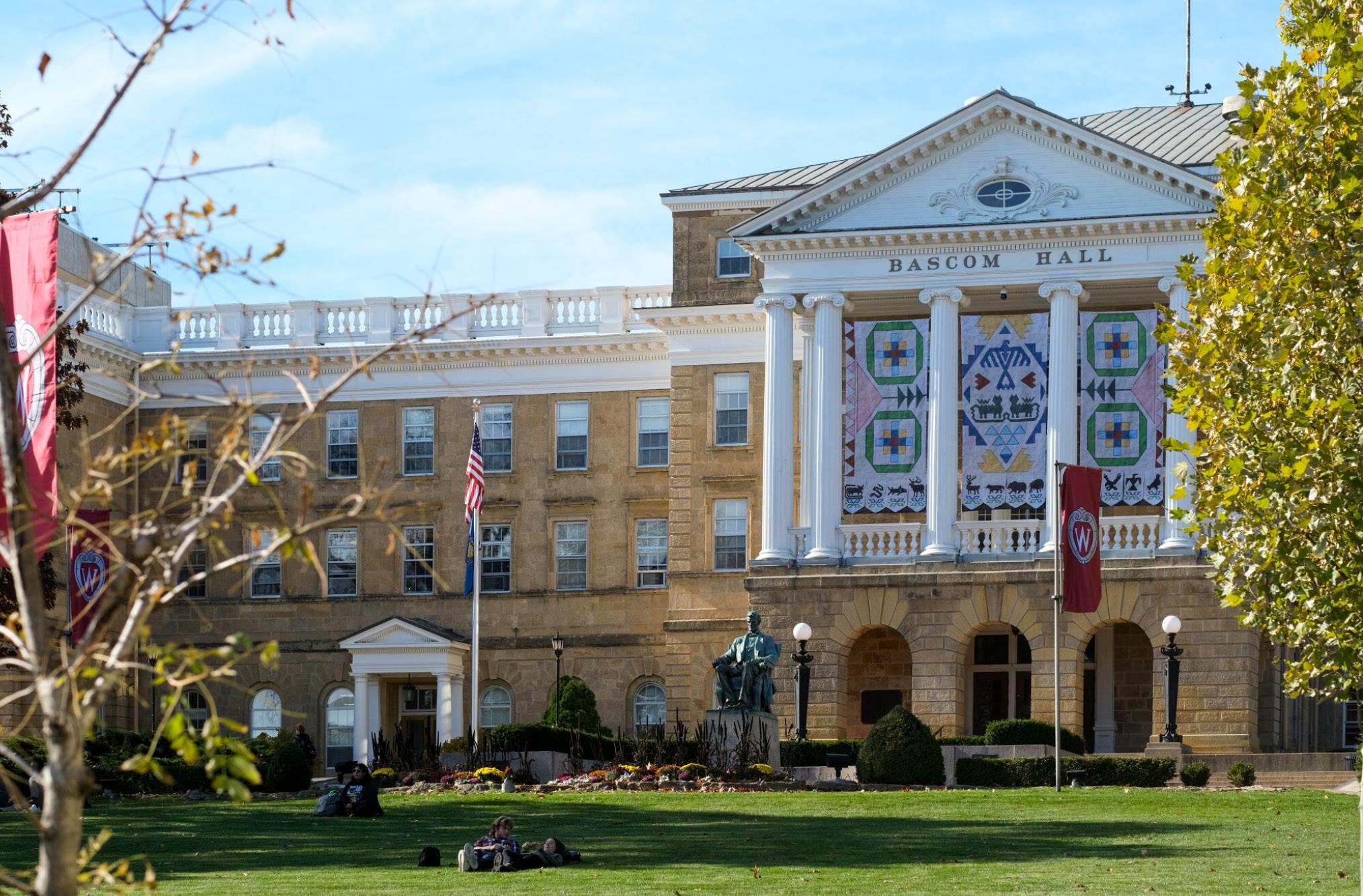
McNulty and Staples went through several different channels, resubmitting the paperwork twice. Though eventually it was sorted out, McNulty was frustrated. This was just another instance of college bureaucracy putting stress on her students.
McNulty shared with the Cardinal a 23-page report that she said was submitted to the UW System Tribal consultation meeting last April. Nearly every barrier she describes — including mail carriers not delivering transcripts in time for enrollment and students being unable to complete FAFSA applications due to a poor internet connection — is accompanied by an anecdote from her students. Staples is one of those anecdotes.
McNulty argues in the report UW System doesn’t accommodate students who aren’t the typical suburban high school senior. Her students take non-traditional paths of education, and they don’t always go to four-year colleges immediately after high school, she said.
Staples is one such non-traditional student. Staples, 63, attended Mount Senario College in the 1980s and raised five children as a single parent. He works at the addiction recovery program Wings of Migizi after experiencing addiction and was recently pardoned by Gov. Tony Evers for four felonies.
Staples took his first Ojibwe language class in 2020 but couldn’t walk the stage due to the COVID-19 pandemic. He went back to school because he wanted a proper graduation.
“I was looking forward to it my whole life,” Staples said. “I haven’t walked on stage since I graduated in 1980, and this is really accomplishing not only for me, but for my sobriety.”
Many students aren’t looking to get a bachelor’s degree. Doane and McNulty’s students often work full-time, have families or are in their 40s and 50s with partially completed degrees. Four straight years of university doesn’t always fit.
sometimes forgotten, and that was done specifically through policies of termination and assimilation,”Blackdeer said. “All of that was done on purpose.”
Though most of these schools were closed in the 1970s, tension remains. Blackdeer feels many higher education institutions don’t understand Native Americans and wants more education on Indigenous peoples. During her freshman year, she had a “racially charged” experience with some individuals from her residence hall. After student protests against a racist video in the spring of 2023, Blackdeer didn’t think UW-Madison Chancellor Jennifer Mnookin responded strongly enough to the incident.
Doane said at least four of her students have independently told her not to send Native students to the schools they were attending due to racist interactions.
“They’ll say ‘I feel very alone on campus, I don’t feel well represented, I don’t feel welcomed, I don’t feel accepted.’ They at least want to give that future student the heads-up,” Doane said.
Still, many in academia are looking to make college better for Native students, including Mike Martin, the interim chancellor of UW-River Falls.
UW-River Falls sits at the edge of the Twin Cities metropolitan area, which has a sizable Native population. It’s also just under two hours away from the St. Croix reservation. They’ve had a tough time with enrollment, but Martin thinks Native students could fill empty classrooms.
“The more difference you can bring to an institution, the more you can feed the curiosity that makes us who we are,” Martin told the Cardinal.
Last year, UW-Madison announced the Wisconsin Tribal Educational Promise Program, a scholarship for Wisconsin Indigenous students to have all educational costs not covered by FAFSA paid for. Blackdeer is one of the first students to receive the scholarship. Most tribes offer scholarships, which Doane said encourages many to apply.
Martin is also planning to reach out to Tribal colleges, which are typically two-year institutions. A 2+2 program is where students earn their associates at a two-year institution before transferring to a four-year institution. An established connection between UW-River Falls and nearby Tribal colleges could benefit both institutions, Martin said. But he knows there’s hesitancy.
“Folks like me have shown up, alleging to help them, and haven’t done a very good job of it. There’s not always as much trust as you would like to have created,” Martin said.
Having Native Americans as role models on campus is great for encouraging enrollment, Doane said. Martin proposed sharing Indigenous faculty with the Tribal colleges or establishing an Indigenous housing community. At New Mexico State, he let tribes use practice football fields for powwows, which he considered a relatively cheap expense for the school that made a positive impact.
“For the first time, many of the parents as well had never been on a campus, and they discovered it wasn’t frightening, and there were nice people there, and all those little things you do begin to send a message that matters,” Martin said.
Visibility is key for Blackdeer. She praised UW-Madison for its vibrant Indigenous community. There are a variety of student groups, such as Wunk Sheek or the Indigenous Law Student Association. The friends she made from these groups have given her great support.
By Elijah Pines SENIOR STAFF WRITER
In an age of declining enrollment, academia is working to bring more Native students to campus.
University of Wisconsin-Madison junior Paige Blackdeer is one of the few students from Black River Falls, Wisconsin, a town of 3,600 and administrative hub of the Ho-Chunk Nation, to attend college. Blackdeer, who tutored other Indigenous students in Black River Falls, knows firsthand the barriers many Indigenous students face in accessing higher education.
“When I was tutoring, there were so many people that were so smart,” Blackdeer told The Daily Cardinal. “[But] if they were told that they had the opportunity to go to college and if they actually did have the opportunity, I think [are] two separate things.”
Across the country, fewer students of all demographics are attending college — in the University of Wisconsin System only UW-Madison and UW-La Crosse did not experience drops in enrollment and end the 2023 fiscal year in a budget deficit. Declining enrollment, years of stagnant tuition and waning state funding has led to system-wide budget cuts and closures of twoyear branch campuses.
With college tuition increasing and budgets being cut, college is becoming less accessible for many. Native Americans are already underrepresented in higher education — only 26% of 18- to 24-year-old Native students were enrolled in college in 2022, compared to 39% of the overall U.S. population, according to NCES.
Distance from home, urban enviornment challenges Native Americans
The St. Croix Chippewa are located in Northern Wisconsin, on the other side of the state from Madison and La Crosse. As the tribe’s higher education coordina-
tor, Janine McNulty’s job is to help students navigate college. But she doesn’t recommend her students apply to UW-Madison.
“I know that our kids need way more support in a smaller, more intimate school, and they would drown in Madison,” McNulty said.
Though Forest County Potawatomi Higher Education Director Mary Doane said UW-Madison’s multicultural population and exciting opportunities make it a “favorite” for her students, many of her students don’t want to be so far from home.
“If they live on the reservation and they want to be close to home, they know that they’ve got to be close to family and they don’t want to miss out on the cultural aspect,” Doane said. “Generally, if they don’t live on the reservation, they don’t need to be close to home.”
McNulty noted her students don’t like schools located more than two hours away. Wisconsin reservations are mostly rural, and while most Native Americans live off reservation, they still disproportionately live in rural areas. Madison and La Crosse are both urban centers more than two hours from the St. Croix and the Forest County Potawatomi.
But it isn’t just Madison and La Crosse located far away. McNulty describes the St. Croix as an “education desert,” meaning an absence of a college within an hour of the tribe. With UW branch campuses and rural colleges closing, rural students are enrolling in college less across the board. The National Student Clearinghouse Research Center found that only 55% of rural 2023 high school graduates enrolled in college, compared to 61% in 2016.
For the students Blackdeer tutored, the problem of college is two-fold. On one hand, many of the students didn’t believe they were capable of going to college, a belief often seen in first-generation students. On the other hand, many couldn’t afford to.
Despite not recommending it for other students, McNulty’s son goes to UW-Madison.
“He would be a third-generation student,” McNulty said. “I can give him the confidence that he needs to be able to go to a big school.”
When asked what barriers their students face for college, both Doane and McNutly said their first-generation college students struggle more than others. Native American students disproportionately have parents without college degrees. Only 23% of Native American children had a parent with at least a bachelor’s degree in 2021, according to NCES.
“Is it talked about in the house? Is it daily conversation? Is it a value? In some of the homes, it’s not,” Doane said.
The non-traditional path beyond suburban high school
Perry Staples enrolled in an Ojibwe language class at UW-Eau Claire at Barron County on a scholarship from the St. Croix Chippewa, and McNulty had filed the paperwork to pay his tuition. For several months, Staples focused on his studies until just before the next semester when Staples received a letter in the mail alerting him he didn’t pay tuition.
“It put a damper on my end,” Staples said. “Like, I can’t afford this.”
Doane and McNulty know this, and they advise their students based on what’s best for them. Both agree that it can lead to higher degrees down the road.
“The success of earning a GED leads to an associate’s degree followed by a bachelor’s degree and now into a master’s degree,” McNulty wrote in her report.
Doane’s education department is beginning to advertise more adult education and technical schools. They have a summer youth employment program where students shadow different tribal departments and learn about different career paths. Even Staples encourages his members to get a degree while in recovery, adding classes are a tool to get better.
“Maybe for some of the students, college isn’t the answer right now, but it is later, so we just try to build that confidence, build those positive relationships,” Doane said.
Once a tool for oppression, U.S. education system still poses difficulty, Native Americans say
The relationship between Native Americans and the U.S. education system is a tense one. The U.S. weaponized schooling against Native Americans in the 19th and 20th centuries, with the Bureau of Indian Affairs kidnapping children and enrolling them in far-away boarding schools. Administrators prevented children from speaking their native language and forcibly converted children to Christianity. Many Native Americans often faced abuse. A common slogan used in these schools was “Kill the Indian, Save the Man.”
The abuse was so significant that some boarding schools had graveyards. The U.S. Department of the Interior identified at least 973 known American Indian, Alaska Native and Native Hawaiian children who died under boarding school care, according to a report published in July of 2024.
“I think that Native American people as a whole are
This isn’t Martin’s first time growing Native populations on campuses. He’s had a long career in the administrative side of academia and has worked extensively with Native Americans academics, Tribes and Tribal colleges. As president at New Mexico State University, he helped build a $5.3 million American Indian Student Center, which helped boost enrollment.
“The first thing we’re trying to do is to bring some advice to our folks from people who know,” Martin said.
Over his career, Martin said Native American officials in higher education have given him insight on what Native students need to feel comfortable on campus. One friend of his is Arthur Butch Blazer, a member of the Mescalero Apache Tribe, who served under former President Barack Obama as a Deputy Under Secretary for the USDA. Martin said Blazer has been a “guiding light” on how to create relationships with Tribal colleges and Tribes.
“I learned from Butch that ask, don’t tell. Listen, don’t sell,” Martin said. “His attitude is [that] you should show up and be genuinely curious about what things other people are curious about.”
Ideas are already swirling.
UW-River Falls has one of only three UW System schools with an agricultural and life sciences college. Martin is interested in creating a food science initiative in tandem with Indigenous Food and Agriculture Initiative, which aims at bringing traditional foods back to Indigenous communities. Janie Hipp, a member of the Chickasaw Nation and founder of the USDA’s Office of Tribal Relations, founded the initiative.
McNulty strongly believes the application process scares off many students. In her 23-page report, she suggests gateway classes, like the one Staples took, to help build confidence for potential students.
There’s lots of options, but the first step into getting Native students on campus is to build relationships with them, McNulty, Staples and Blackdeer all agreed on.
UW System hosts tribal consultations on a regular basis to hear about the Tribe’s concerns, UW System spokesperson Mark Pitsch told the Cardinal. Each university and each Tribe are different, and many approaches are being considered, Pitsch said.
“While we are always looking for ways to support the success of Native American students, we recognize there is more to be done,” Pitsch said. “We are working with the universities and the Tribes to address issues and build capacity toward successful student outcomes, including by smoothing pathways to our universities and supporting students after they enroll.”
‘I feel very alone on campus, I don’t feel well represented, I don’t feel welcomed, I don’t feel accepted.’
Despite college enrollment declines, both Doane and McNulty said they are serving more students than they had at the start of their careers. There is still an interest in higher education and many passionate people working to make college more accessible, they said. For Indigenous students, ongoing work from all levels of academia provides hope for change.
There’s also the potential for tuition decreases. Though education budgets have been tight, Martin said budget cuts haven’t been in proportion to enrollment decreases. Martin thinks that decreasing tuition for targeted populations could bring in more students without the University incurring any costs.
“When [Native Americans] go to college, they learn, just like everyone else, about the global world. Colleges are filled with building of confidence,” McNulty said. “They learn to be advocates. They learn their history. They have opportunities to learn culture and language that is outside the tribal community, and they get prepared to come back to their tribe and pull their tribe up a little higher.”
By The Daily Cardinal EDITORIAL BOARD
The National Institutes of Health (NIH) have long been a pillar of medical and scientific advancement in the United States, funneling billions of dollars into universities to support groundbreaking research. But a recent decision by President Donald Trump to cap funding for university research — a decision currently blocked by a federal judge — threatens to upend this system, potentially jeopardizing not only the progress of scientific discovery but also the economic stability of research institutions across the country.
At the University of Wisconsin-Madison — the sixth largest research university in the country — this cap would translate into an annual loss of approximately $65 million in research funding. The nationwide impact is even more staggering, amounting to billions of dollars in cuts for institutions that rely on NIH grants to support their research infrastructure. The hardest hit area would be indirect costs, or Facilities and Administrative (F&A) costs, funds that cover essential expenses like laboratory equipment, research facilities and staff salaries.
By slashing these funds, Trump is not just cutting back on “administrative overhead” — he is actively dismantling the support systems that make break-
through research possible in the first place. It is imperative that this cap does not move forward.
The false logic behind the cap
The justification behind Trump’s decision is reducing administrative overhead and spending on indirect costs allows more money to be spent directly on research.
But this reasoning is not just flawed: it is dangerous. Research cannot exist in a vacuum. Laboratories need funding for equipment, technicians and compliance measures. UW-Madison, like other universities, needs funding to maintain facilities where research can take place. Without proper investment in these indirect costs, projects will stall, faculty will struggle to conduct experiments and institutions will continue to face mounting financial strain. Consider this: UW-Madison currently spends around $18.8 million per week on federal research expenditures, with indirect costs accounting for a substantial portion of that budget. The university’s current indirect cost rate ranges from 27% to 55%, meaning that a hard cap at 15% would significantly disrupt ongoing and future research efforts.
The NIH funding cap is more than an inconvenience. It is an existential threat to many of the university’s most critical research initiatives.
Federal research funding has been instrumental in fostering some of the most important medical breakthroughs in recent history. UW-Madison Chancellor Jennifer Mnookin recently released a statement highlighting the role of federal funding in pioneering research advances like the “UW Solution,” a discovery that has extended the viability of organs for transplantation. Other breakthroughs funded through federal research grants at UW-Madison include advancements in cancer and heart attack treatments, medical imaging improvements and innovative diabetes therapies. Without sustained investment in indirect costs, these critical innovations could grind to a halt. Scientists who depend on reliable funding to carry out experiments may find themselves without the necessary infrastructure to continue their work.
The implications of this funding cap stretch far beyond UW-Madison. Research universities across the country depend on indirect cost support to maintain their operations. Without it, institutions will be forced to either absorb these costs themselves — potentially passing the financial burden onto students through
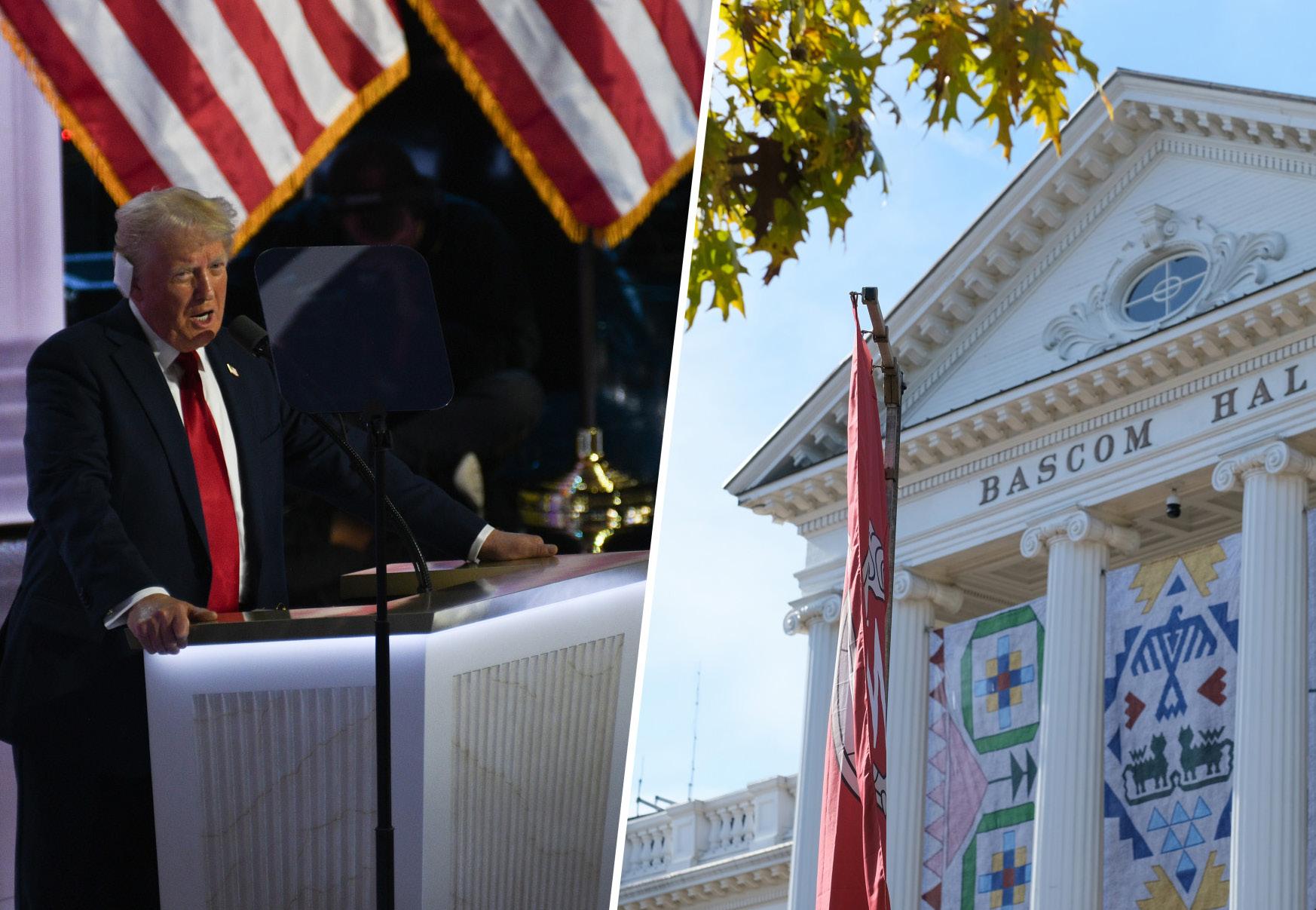
higher tuition — or cut back on research activities altogether.
This is not just about the survival of individual universities; it is about the broader impact on public health, technological advancement and economic growth. The U.S. has historically led the world in medical and scientific research, largely due to its robust federal funding system. Trump is weakening that system which threatens the country’s ability to remain at the forefront of global innovation.
In a time when the world is facing urgent health crises, from pandemics to climate-related medical challenges, the last thing we should be doing is hampering the institutions that are best equipped to find solutions.
Universities and research institutions must continue to make their voices heard, and lawmakers must step up to protect the integ-
rity of the nation’s research funding system. The NIH, rather than seeking to arbitrarily cut costs, should be working with universities to ensure that research funding is both efficient and effective. We cannot afford to treat research funding as an expendable budget item. The longterm consequences of these cuts will far outweigh any short-term financial savings. Scientific innovation is not something that can be switched on and off at will; it requires sustained investment, careful planning and an infrastructure that allows researchers to thrive. The Trump administration must abandon this ill-conceived cap and recommit to a funding system that prioritizes not just the immediate needs of research projects, but the long-term sustainability of the research enterprise as a whole.
By Aidan Cummins STAFF WRITER
True to my nature as a political science student, I’ve spent much of the first few weeks of the semester examining the Constitution, founding documents and Supreme Court cases in excruciating detail. That said, it’s come as a shock to me how relevant the debates of the 18th and 19th centuries are today. You would think that both time and legal precedent would have solved or at least provided some insight into the major questions of American Constitutionalism.
Well, you’d be wrong — and it’s evident in today’s political landscape.
Our current executive has pushed many of those unanswered questions back into the limelight, leaving our government to test the limits of its checks and balances system once again. For much of our history — with a few exceptions — this system has worked. Our three separate but co-equal branches of government have duked it out between each other to make sure that no one’s getting more power than constitutionally allowed. The American presidency has been defined by the idea that “it’s easier to ask for forgiveness than permission” combined with a healthy dose of “act now and ask constitutional questions later.” It even worked quite well during Trump’s first term.
So, what’s so different about President Donald Trump this time? This time, he is backed by a well-oiled political machine with the means and the motives to ensure you end his current term with less rights than you started with, and our constitution
is in crisis because of it.
This is no longer the disorientated Trump administration of his first term, where strong institutional bulwarks spread across the federal and state governments challenged executive authority in both judicial and legislative terms. Over the past four years, the Trump political machine has successfully backed party loyalists in local, state and federal elections, which guarantees the support needed to accomplish his dictatorial aspirations. Opposition within the party has been effectively extinguished, and opposition outside the party is consistently labeled as fake and untrustworthy.
When an executive says they want to “weed out corruption” which includes “look[ing] at the judges” who block his orders, blocks reporters from one of the most well-respected journalistic organizations because it refuses to accept the inane renaming of the Gulf of Mexico and unofficially places an unelected multi-billionaire advisor in control of some of the most critical functions of the government, what do you have?
What you don’t have is a man who swore to dutifully support and defend the Constitution — a constitution of the people, by the people, for the people. You have a man hellbent on concentrating executive power not in the Office, but in himself. With the support of a Republican majority in Congress and a Supreme Court who granted him broad immunity, we are only left with a constitutional crisis.
Political scientists call this “democratic backsliding,” but it’s so much more than that.
Trump has unconstitutionally usurped
control over the steering wheel of democracy, shoved the gear into reverse and slammed on the gas all while making sure you have enough going on to not look up from your iPad in the backseat.
They want you to spend your time complaining about your egg prices and your TikTok ban/not-ban — or whatever they’re doing with that now. Go ahead, gossip with your friends about that one obvious Republican in your gender and women’s studies discussion. Scroll through the headlines, but make sure not to read too closely! Because while you’re doing that, the administration will continue to push through unqualified loyalists to cabinet-level positions, seize powers constitutionally granted to other departments and continue to destroy the very foundation of our constitutional democracy.
We are a nation of popular sovereignty, a nation where we uphold the values of liberty, equality and justice. A nation where we hold our rulers accountable. We are “we the People” who fought a despotic monarch to ensure the rule of law and guarantee that Americans would never again be under such rule. We are the shining city on a hill where all nations of oppressed peoples can look to for inspiration on how to achieve a more just society — a more perfect Union.
But I hate to break it to you, we shine no more.
The lights may be off, but democracy doesn’t die in darkness. It dies in a nightclub where there are a thousand multicolored lasers pointed at your eyes with strobe lights and music so loud you have no clue what’s even going on. The age of the internet has made us too connected to divide
and conquer. It’s distract and conquer. It’s a constant stream of headlines, executive orders, court orders, resignations, appointments, agreements and debates all aimed at disorienting you so you can’t sort out the funny from the fascist.
Now is not the time for moral trepidation or timorous certainty — now is the time to harken back to our foundational sentiment. We are the nation of righteous revolutionaries, civil disobeyers and unyielding defenders of justice. It can feel ridiculous to speak out against our own government’s malfeasance because how could it ever happen here? Remember, everywhere the “it” has happened, everyone asked themselves the same question — Germany, Italy, Poland, Brazil, France, Russia, Japan, Turkey, Hungary, the list goes on.
Right-wing populist executive takeovers can happen anywhere at any time. We are no better.
It is our responsibility, as Americans, to oppose our government when our government opposes us. Stay informed and stay paying attention because the devil truly is in the details. There will never be a headline or an executive order that says “THIS RIGHT HAS BEEN TAKEN AWAY,” but through constitutional passivity day by day and year by year, things will erode. We need to stand up and speak out now — for ourselves, our way of life, our government and our beloved Constitution.
Aidan Cummins is a senior studying Economics,PoliticalScienceandPersonal Finance. Do you agree our constitution is in crisis? Send all comments to Opinion@ dailycardinal.com

By Jakob Moe STAFF WRITER
Gov. Tony Evers announced a new rule on Jan. 28 lowering the threshold for lead poisoning in Wisconsin, aligning it with Centers for Disease Control and Prevention (CDC) guidelines.
The rule will reduce the threshold from five micrograms per deciliter to 3.5 micrograms per deciliter, identifying more children with lead poisoning and connecting them to critical health services.
The measure, enforced by the Wisconsin Department of Health Services (DHS), is the latest attempt by Evers’ administration to combat lead exposure, particularly in Milwaukee, where thousands of children are at risk.
The rule change comes as part of Evers’ broader initiative to combat lead contamination statewide. In his 2025 State of the State address, Evers declared 2025 as the “Year of the Kid,” touting the importance of children’s health, education and safety.
Statewide efforts to address lead contamination
In his State of the State address, Evers proposed over $6.2 million in the state budget for lead poisoning intervention and response for local health departments. This funding will be used to expand testing, provide medical support to affected children and implement early intervention services.
“Making sure our kids are healthy — physically and mentally — is a crucial part of improving outcomes in our classrooms,” Evers said. “But we have to connect the dots between school achievement and the challenges our kids are facing at home and in our communities.”
The proposed budget also includes investments to improve drinking water at water fountains in schools and financial
assistance to homeowners for replacing lead service lines, which all property owners, regardless of income, must replace on their own.
Milwaukee’s lead crisis and funding shortfalls
Milwaukee remains the epicenter of Wisconsin’s lead crisis, with an estimated 65,000 residential lead service lines still in use. Since 2017, the city has replaced over 8,000 lead service lines, with another 3,500 replacements planned for this year. However, officials estimate that fully replacing Milwaukee’s lead pipes will require $700 million over the next 13 years.
While some funding is available, such as $26 million in federal pandemic aid allocated in 2021 for lead paint abatement, $6.2 million to increase grants for local health departments in 2025 and $83 million in aid from the federal Bipartisan Infrastructure Law, a significant financial gap remains. Furthermore, securing additional funding from the state has remained difficult due to opposition from Republican lawmakers.
Republicans have argued that lead pipe replacement should be addressed at the local level. In 2019, Assembly Speaker Robin Vos, R-Rochester, expressed support for alternatives such as providing residents with drinking water filters instead of funding large-scale pipe replacement projects.
Evers has criticized the Republican-controlled Legislature for opposing investments in lead remediation.
“While Republican lawmakers have failed to provide meaningful state investments to help get lead out of our pipes and water, we are grateful to the Biden-Harris Administration, federal partners, and the Bipartisan
By Jake Piper STAFF WRITER
University of WisconsinMadison researchers received a $5.5 million grant from the U.S. Department of Energy on Jan. 10 to study methods to reduce synthetic nitrogen fertilizer use in crops.
The multi-university project, led by Dr. Jean-Michel Ané, UW-Madison professor in the Department of Plant and Agroecosystem Sciences and the Department of Bacteriology, looks to reduce synthetic nitrogen use in corn and sorghum. These two crops are used in the United States’ biofuel production, with corn accounting for 94% of ethanol production in the U.S.
With the U.S. producing over 389 million tons of corn every year, Ané and his team hope to reduce overall fertilizer use through the crossbreeding of non-native corn variants and the genetic modification of nitrogen-fixing bacteria.
Infrastructure Law for supporting this important work in Wisconsin,” Evers said.
Republican lawmakers have not yet indicated whether they will support any lead remediation funding in their upcoming budget, but if blocked again, Evers’ administration may need to rely exclusively on federal funding to continue addressing the issue.
Statewide impact of lead contamination
While Milwaukee has the most severe lead contamination issues, many other Wisconsin cities struggle with aging lead pipes. Many municipalities are expected to seek state funding, but without additional state support, progress could be slow.
Earlier this month, the state announced the Lead Service Line Replacement Community Outreach Grant, aimed at helping municipalities educate residents about lead removal programs and collaborate with community organizations.
“This new grant program will provide much-needed outreach funding to support lead service line replacement,” said Steve Elmore, the Wisconsin Department of Natural Resources’ Drinking Water and Groundwater program director. “This is an ideal time for municipal systems to foster trust and cooperation with their customers while, at the same time, safeguarding the quality of their drinking water.”
With Milwaukee still in need of hundreds of millions of dollars for full lead service line replacement and other cities facing similar challenges, securing long-term funding remains a critical issue. Whether state lawmakers will support Evers’ proposals — or whether the administration will be forced to seek alternative solutions — remains to be seen.
Ané’s team is now looking for ways to cross-breed this corn with American variants, creating a crop that harnesses more of an ecosystem’s available atmospheric nitrogen through the same open-air roots.
However, a key limitation with olotón corn is the U.S.’s comparatively shorter growing season, Ané said. Some regions in Mexico allowed the corn to grow for multiple years, something he said wasn’t possible in many regions of the U.S.
To adapt to the high demand and faster turnover rate of American agricultural practices, Ané and his colleagues are looking to introduce genetically modified nitrogen-fixing bacteria into the soil, which would act as a nitrogen source before the development of the open-air roots, combining his decades worth of research in a “complimentary” way.
Nitrogen fixation, a biological codependency which is vital for all plants, occurs when certain types of bacteria create a symbiotic relationship with their host plant. The bacteria is given a safe place to culture in exchange for converting nitrogen in the air into ammonia that both the bacteria and plant can use to grow.
Traditionally, American variants of corn fix only about 0.5% of available nitrogen for use in bacteria and the host plant, but Ané said with his team’s research and ongoing discoveries, he’s optimistic that number could be increased to 20%.
Ané said his scientific journey with this experiment first started over 10 years ago, when researchers discovered a strain of corn in Oaxaca, Mexico which could receive over 50% of its needed nitrogen from fixation.
“My first reaction was, ‘no way.’ And it took us about eight or nine years for us to convince ourselves that it was true,” Ané told The Daily Cardinal.
The key difference between American breeds of corn and the Oaxaca corn, locally known as olotón, is the large open-air roots that line the plant and secrete a mucus-like gel, which hosts nitrogen-fixing bacteria and allows olotón to effectively self-fertilize.
“I’ve been looking into approaches to take microbes that already fix nitrogen on corn and modify them genetically to force them to fix more nitrogen and to release that nitrogen to the plant,” Ané said.
Their process of genetic modification is a less traditional route than what the average person might think of, Ané said. His team uses a process called cisgenic modification. Unlike traditional genetic engineering which uses foreign DNA, cisgenic modification simply involves “moving pieces of DNA within the same bacterium,” he said.
Project(ed) future
Ané worries the future of his research may be in jeopardy with President Donald Trump in office. He said he has had little communication with the U.S. Department of Energy since the government agency canceled a meeting between them.
However, Ané said he was still “a bit optimistic” about receiving funding despite current setbacks.
“Because it’s a project which is fairly applied, it’s really to translate the basic research that I’ve done for decades to practical applications. And I guess that’s what people want now. So it’s really translating the science we do in academia, to industry,” Ané said.

The Wisconsin Badgers are in sixth place in the Big Ten standings and control their Big Ten Tournament seed heading into the weekend.
By Haellie Opp STAFF WRITER
The Wisconsin men’s hockey team (11-18-3) is ranked sixth in the Big Ten Standings, only ahead of Notre Dame. Wisconsin will play the Fighting Irish this weekend at home, but even losing both games wouldn’t put Notre Dame ahead in the rankings.
In the Big Ten Tournament picture, the Badgers are looking for some luck to jump to the No. 5 seed. This will happen if No. 1 Michigan State sweeps Penn State and Wisconsin sweeps Notre Dame this weekend.
If Wisconsin finishes with the No. 5 seed, they will play the No. 4 seed Michigan, a team that the Badgers could match up against well this season. This series could really test both teams, and with three games played, lead to either outcome.
If Wisconsin finishes with the No. 6 seed, which is likely, they’ll play a three-game series against No. 3 seed Ohio State, the team that beat the Badgers every time the two played this season. Wisconsin
would face a strong team offensively that swept them 4-1 and 4-2 last weekend.
While Penn State tries to avoid getting swept two weekends in a row, they are playing top-ranked Michigan State. If Penn State earns the upset, Wisconsin will play Ohio State. The Badgers will need to be strong defensively and have a goaltender that can stop whatever gets through the defense.
Sophomore Quinn Finley has been on a scoring drought. He hasn’t recorded a single point since Jan. 25 against Michigan, going six games without a goal or an assist.
The Badgers will need the player that scored 19 goals and recorded 24 points this season to compete with Ohio State’s Gunnarwolfe Fontaine, who has 31 points this season. Fontaine is followed closely by Riley Thompson and Davis Burnside, both of whom have 28 points.
As for the current Big Ten Tournament seeding, Michigan State took the No. 1 seed on a bye week where they already have a spot in the semifinals single elimi-
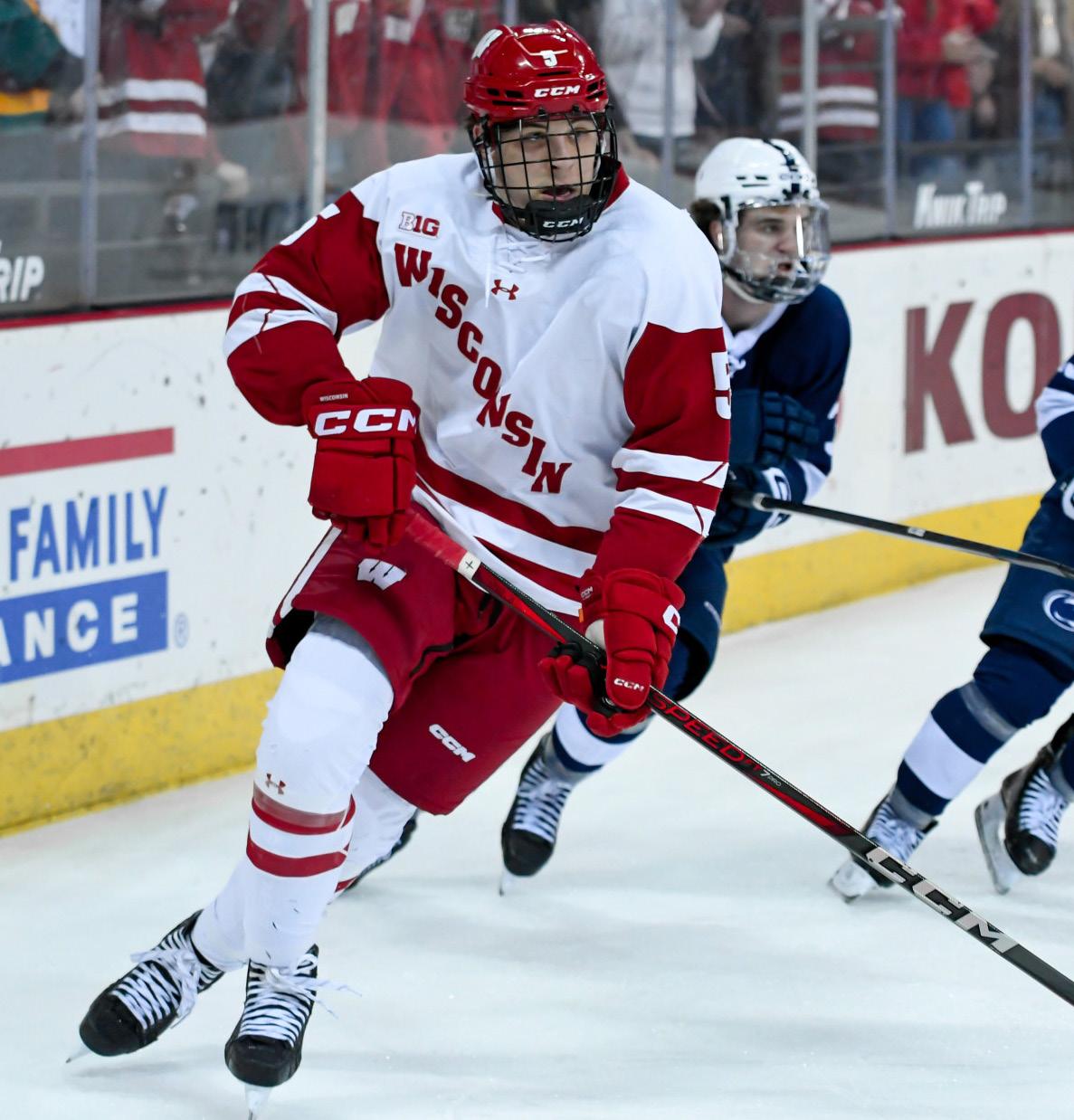
nation round. No. 2 seed Minnesota will play No. 7 seed Notre Dame in the quarterfinals, likely advancing to the semifinals with a sweep of the Fighting Irish.
Currently, No. 5 seed Penn
State will play No. 4 seed Michigan, a game that could go either way. In the semifinals, the winner of this series is likely to end up playing No. 1 seed Michigan State.
If Wisconsin wins against
Ohio State and Notre Dame loses to Minnesota, Wisconsin would then have to play Michigan State.
Wisconsin has a difficult road ahead of them, but a three-game series to start off has one extra game that they may need to fall back on. The likelihood that the Badgers jump to the No. 5 seed is slim, so preparing to play Ohio State is their best opportunity for success.
If Wisconsin pulls off two wins against Ohio State and a win against Michigan State, they are likely to face Minnesota. Wisconsin and Minnesota had close games this season in Wisconsin and fell apart when they played in Minnesota.
Playoff hockey is a different game and Wisconsin does have a chance, but they need their leading goal scorer, littleto-no penalties and confidence in their goaltenders for that postseason playoff push.
The Badgers will play their last regular season series at the Kohl Center against the Notre Dame Fighting Irish this weekend to determine their Big Ten Tournament seed.
By Jacob Szczap SENIOR STAFF WRITER
The Wisconsin Badgers arrived in West Lafayette, Indiana, this weekend already in the midst of an impressive season. But after upsetting the No. 7 Purdue Boilermakers 94-84 in front of a packed Mackey Arena Saturday afternoon, Wisconsin left demanding the respect of the nation.
With a rip-roaring, 58-point second half, the Badgers overcame a ninepoint deficit in the foul-troubled first half and the controversial ejection of a
key player to secure their most impressive win of the season.
Led by the emerging stardom of guard John Tonje, who scored 32 points on 10-15 shooting with six rebounds and three assists, Wisconsin’s offense continued its season-long tradition of dicing up opposing defenses. Guard Max Klesmit scored 17 points, shooting 5-10, with six assists. Forward Nolan Winter contributed 12 points, while John Blackwell and Jack Janicki each added 11.
“They’re just extremely confident.
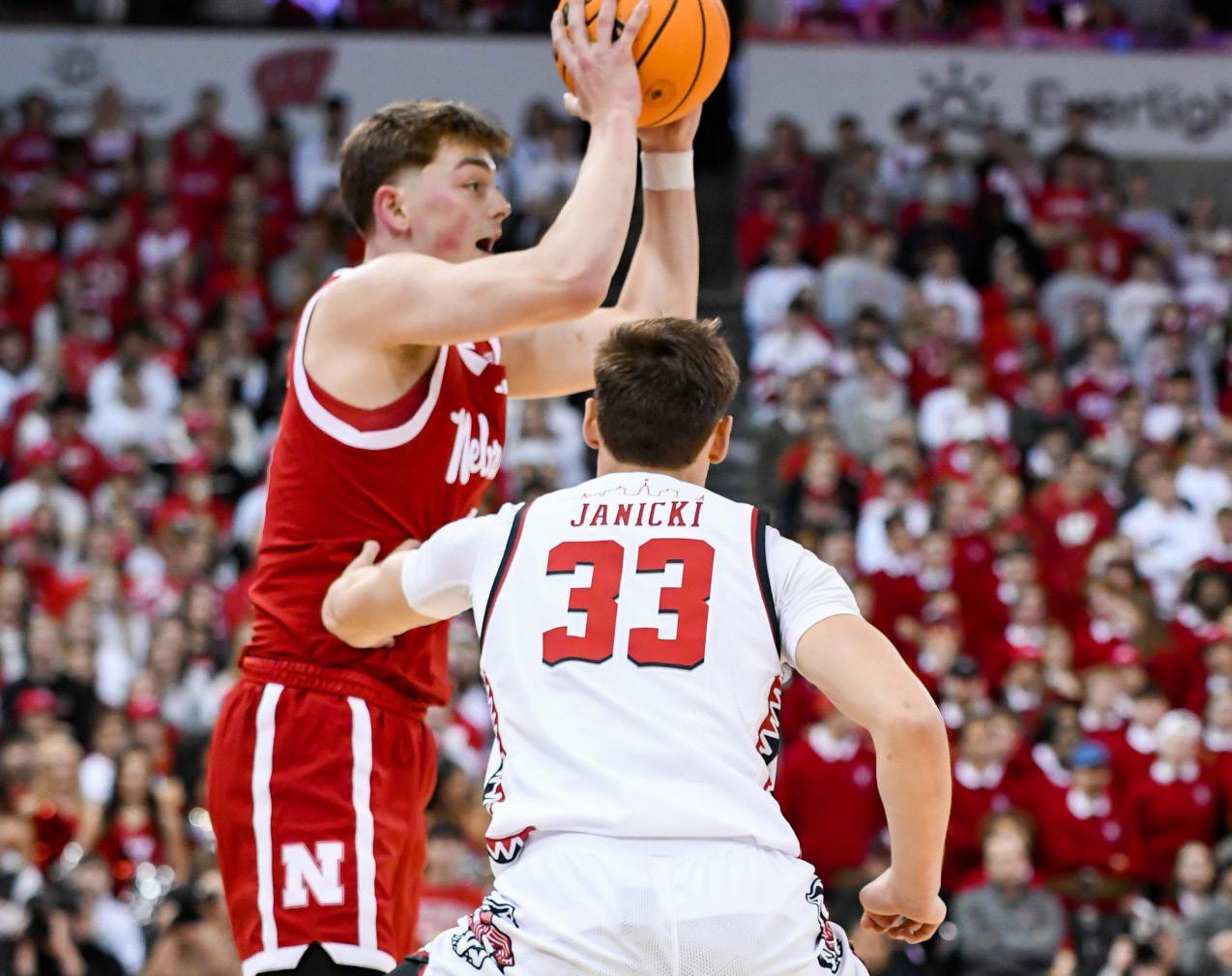
They know, collectively, they are a really good team,” head coach Greg Gard said of his team after the game. “And obviously, we’ve got major star power too with some guys, but just how they rallied together.”
A career-high 30 points from Purdue forward Trey Kaufman-Renn wasn’t enough to propel the Boilermakers, who largely controlled the first half.
In a close first half, early foul trouble almost doomed the Badgers. With 6:46 remaining in the half, Blackwell picked up his second foul, forcing him to the bench for the remainder of the half. Then, at the 6:20 mark, key bench player Kamari McGee received a flagrant-2, disqualifying him from the game. Chasing Purdue point guard Braden Smith around a screen, McGee came in contact with the midsection of Koffman-Renn hard enough for the officials to deem it ejection-worthy.
With McGee out of the game, Wisconsin, playing in one of the toughest atmospheres in college basketball, refused to back down. The Badgers trailed 31-22 in the aftermath of the McGee ejection, but a gritty finish to the half sent Wisconsin to the locker room trailing only 37-36.
Without McGee, the Badgers knew they would need someone else to step up to emerge victorious. Janicki came to the table, and then some. Janicki averages 10 minutes a game but played 17 on Saturday, using those elevated minutes to reach a career-high 11 points, and three 3-pointers.
“It just shows the maturity of this team,” Blackwell said. “Me picking up
two fouls early and sitting the whole first half and Kamari getting ejected. It just shows (that it’s) next guy up. Jack Janicki stepped up. It just shows our team is a well-oiled machine. We just keep going.”
The beginning of the second half resulted in more of the back-and-forth action of the first half. Then, Tonje began to take over.
With 17:17 remaining, Tonje hit a 3-pointer to tie the game at 45. He then converted on a lay-up and hit another 3-pointer, this time while being fouled. His extra free throw gave Wisconsin a 51-50 lead, one they would not give up.
On Wisconsin’s next possession, Tonje drove for two more points, before Blackwell hit a 3. Tonje capped off his incredible run with a pull-up jumper in the paint to give the Badgers a 58-50 lead. Over Wisconsin’s first 11 possessions of the second half, Tonje scored 13 points, turning the game forever in Wisconsin’s direction.
Wisconsin continued to overwhelm Purdue offensively the rest of the afternoon, shooting 72% in the second half to secure a hard-fought, gritty victory.
In beating Purdue, Wisconsin handed the Boilermakers their second loss of the week. Still two games behind Michigan in the Big Ten standings, the Badgers stay within striking distance of the regular season title.
But more importantly than the standings, with their win over Purdue, Wisconsin showed it can beat anybody on any given day. On the road, against the No. 7 team in the nation, the Badgers took their punches and left smiling.
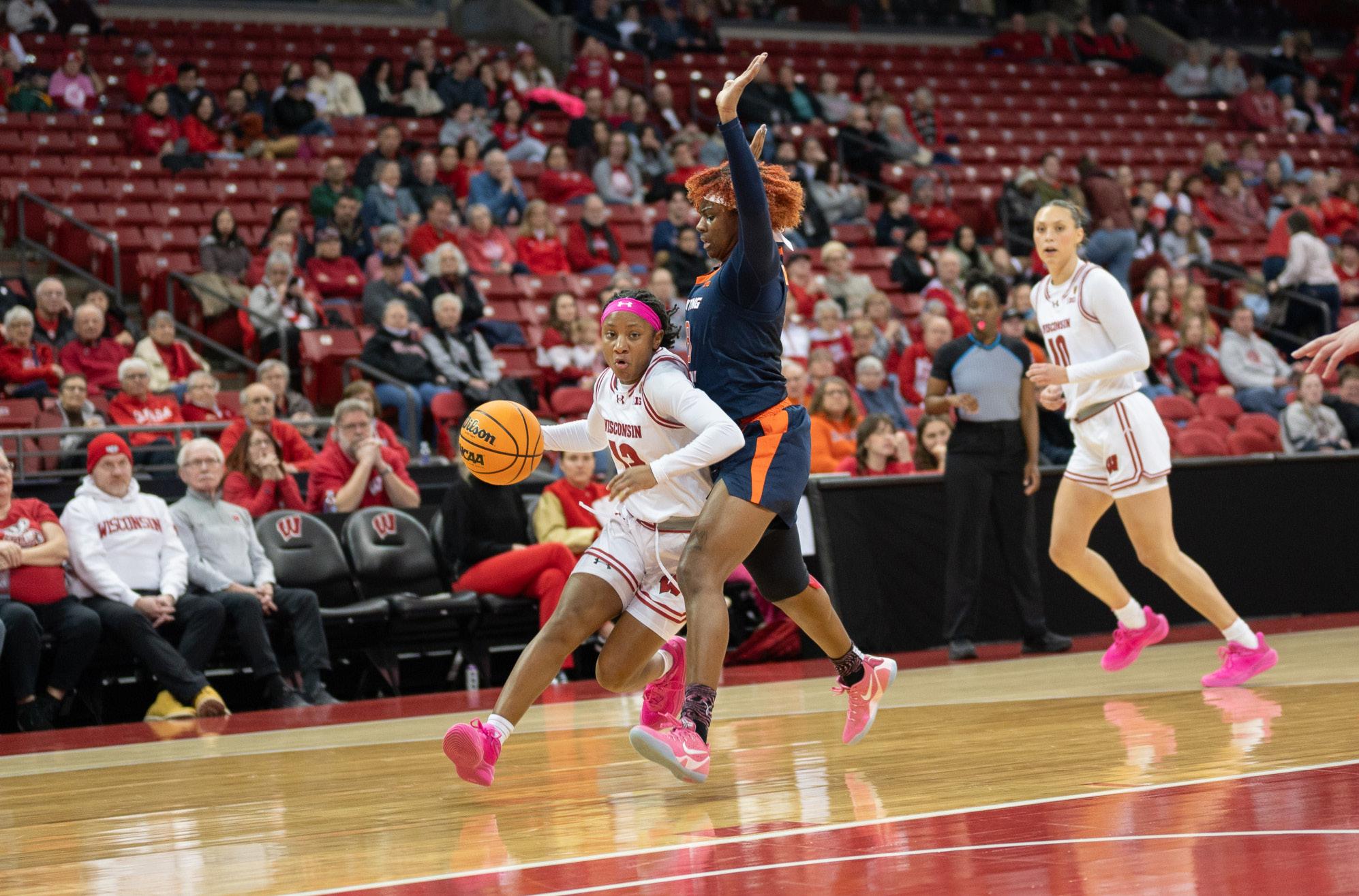
By Yadiel Chavez STAFF WRITER
Going into Sunday’s game against the Penn State Lady Lions, the Wisconsin Badgers women’s basketball team sorely needed a win.
Losing their previous four games against Big Ten competition, their hopes of making it to the Big Ten Tournament rely heavily on how they close out the last four games of the regular season.
Wisconsin managed to win 75-68 over Penn State in a game that showcased the diversity the Badgers offense possesses when firing on all cylinders.
Serah Williams led the Badgers’ offense with 23 points. This is the 10th game during the regular season in which Williams has put up 20 points or more, a showcase of her incredible scoring ability.
Guard Ronnie Porter was the next leading scorer for the Badgers with 18 points. Her dynamic playmaking ability stood out on Sunday, dishing out a season-high 12 assists while only turning the ball over once.
Halle Douglas came off the bench, delivering 17 points with 4-of-7 shooting from 3-point range, and center
Carter McCray followed with 15 points and seven rebounds.
While Wisconsin varied in who provided their scoring, Penn State relied heavily on the efforts of center Gracie Merkle. Her 28 points and 12 rebounds were both game highs for either team, keeping the Lady Lions neck-and-neck with Wisconsin all game long.
Wisconsin has had trouble easing into the first quarter in recent games. The Badgers had to come out strong early if they wanted to change their fortunes, averaging 12 points in the first quarter in the last three games.
Williams was a major part of the uptick of first-quarter scoring, providing 13 of the Badgers’ 21 points during the period.
Penn State kept it close, however, ending the quarter on a 4-0 run to make it a 24-21 for Wisconsin.
The second quarter saw the offensive blows slow down for both teams, with the Lady Lions winning the period 16-13. Merkle was perfect from the field for Penn State, scoring eight of the 16 points for them in the quarter.
Douglas led the Badgers in scoring during the second period, scoring five points in six

By Brendan Wolf STAFF WRITER
Wisconsin cornerback Nyzier Fourqurean was granted at least an extra year of eligibility after being granted a preliminary injunction related to his lawsuit against the NCAA.
In late January, Fourqurean sued the NCAA, arguing that his two years at Grand Valley State, a Division II school, should not count against his NCAA eligibility.
In the lawsuit, Fourqurean argued he was denied the opportunity to profit from NIL by not allowing him to have more eligibility for his time at Grand Valley State.
Fourqurean is seeking two additional years of eligibility in the lawsuit but is only guaranteed one more with the injunction put in place. This was granted because of the Feb. 7 deadline to declare for the upcoming NFL draft, and the lawsuit would not be settled by then.
minutes. At the halftime buzzer, the two teams were tied at 37.
Coming out of the break, Wisconsin struggled to get their shots down. Williams only attempted three shots in the third quarter, leading the Badgers to try and generate offense from the 3-point line. Going 0-of-7 from deep, Wisconsin only managed to score 14 points in the period.
Luckily for the Badgers, Penn State couldn’t keep the ball in their possession. They let up seven turnovers in the third quarter, which offset their 5-of-11 shooting. Offensive struggles from both sides left Wisconsin with a slight 51-50 edge heading into the fourth.
Wisconsin got contributions from their four leading scorers in the fourth quarter, with Douglas scoring nine points, shooting 2-of-3 from 3-point range and 3-of-4 from the free-throw line. Playing all 10 minutes in the quarter, head coach Marisa Moseley trusted Douglas as a fourth-quarter starter in a tight game.
Penn State wouldn’t back down, however, cutting the lead down to one with one minute, 54 seconds remaining in the game. Clutch makes by McCray and Douglas gave the Badgers a six-point lead with 1:08 left, forcing Penn State to play the odds of free throws.
Wisconsin would take care of business at the line, securing the victory and now stand at 12-14 on the season.
Next on the schedule is Northwestern, who currently sits at 17th in the Big Ten standings. With the Badgers sitting at 14th, getting another conference win this close to the end of the season would only further improve their chances at earning a Big Ten Tournament bid.
Wisconsin will return to the Kohl Center and host the Wildcats on Feb. 23.
Vanderbilt starting quarterback Diego Pavia filed a lawsuit against the NCAA in December, saying his two years at the New Mexico Military Institute should not count toward his total because it, like Fourqurean, unfairly limited his ability to profit off of NIL. Pavia was also granted an injunction because of his case, allowing him to play for the Commodores next season.
But Pavia also argued that seasons spent at a junior college should not count toward NCAA eligibility because players have no opportunity to make any money off of NIL or media exposure. Unlike Division II, the junior college football system is not governed by the NCAA, so Pavia’s case is slightly different than Fourqurean’s.
With NIL shaking up college football, conference changes and players’ rights, Fourqurean’s lawsuit could have a massive impact on the future of the sport, even though it does not mean other former Division II transfers will earn extra eligibility.
Fourqurean’s case is unique. He argued that his mental health was significantly affected by the death of his father, which limited his playing abilities at Grand Valley State. But it could still set a precedent for future athletes who might experience similar situations to Fourqurean.
In his two years with the Badgers, Fourqurean has played a key role in the secondary, becoming a full-time starter in the 2024 season. He recorded an interception against No. 1 Oregon, recovered a fumble in the matchup against No. 3 Penn State last year and made 51 tackles on the season.
With the controversial departure of freshman cornerback Xavier Lucas, Fourqurean looks to retain his starting position next to fifth-year senior Ricardo Hallman. After the Badgers’ cornerback room had a mass exodus after the conclusion of last season, Fourqurean’s unexpected presence on next year’s team will be greatly appreciated.

